


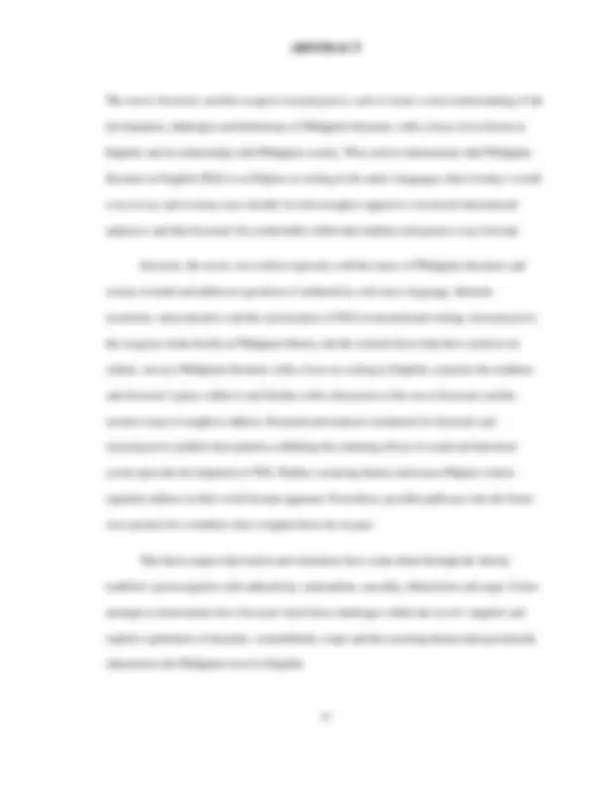
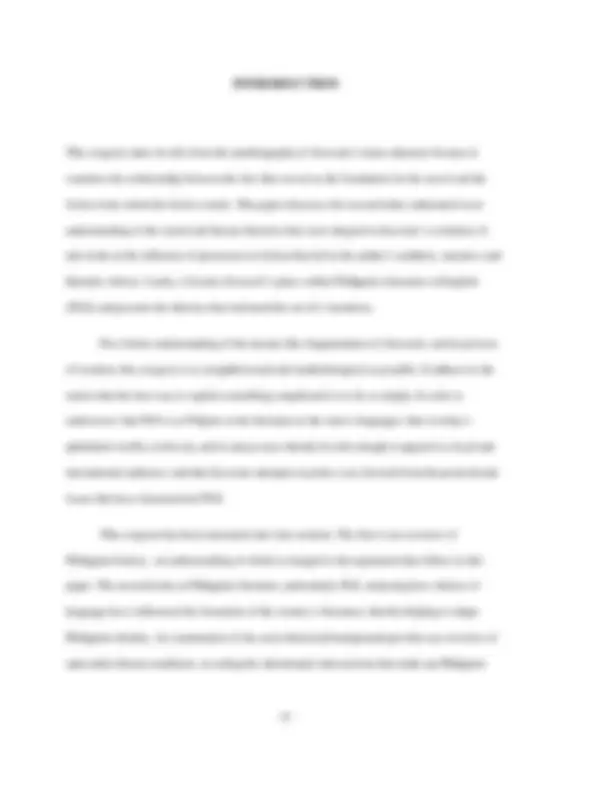
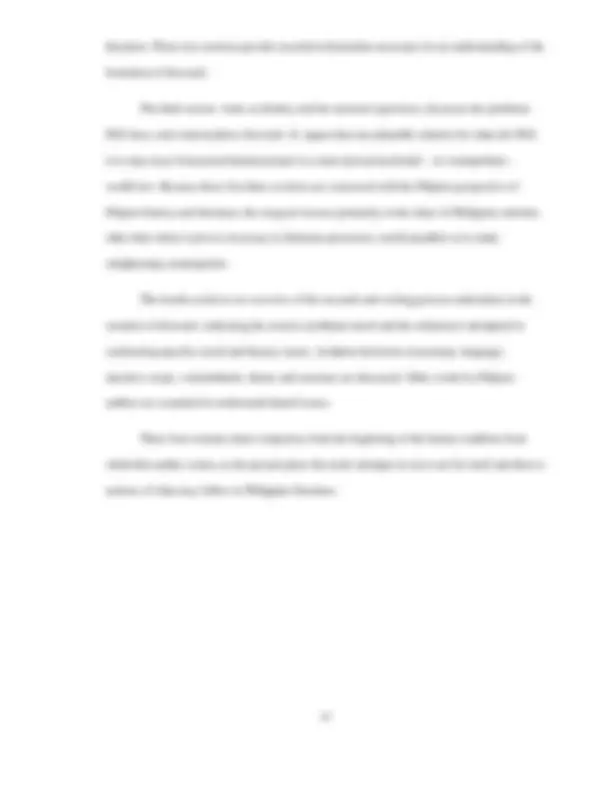
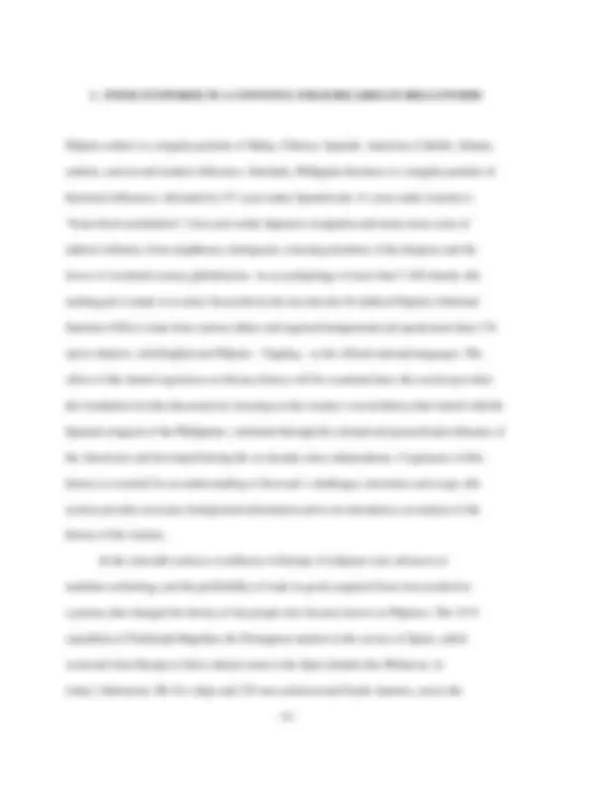
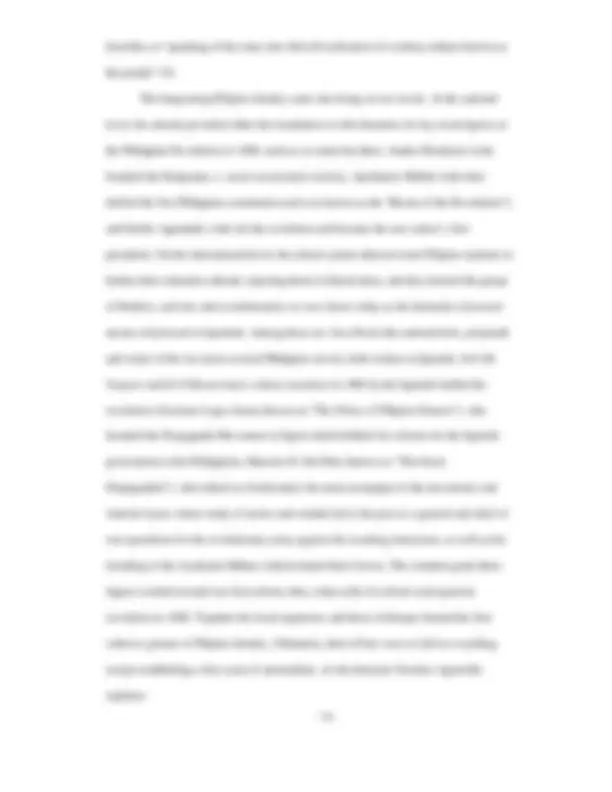
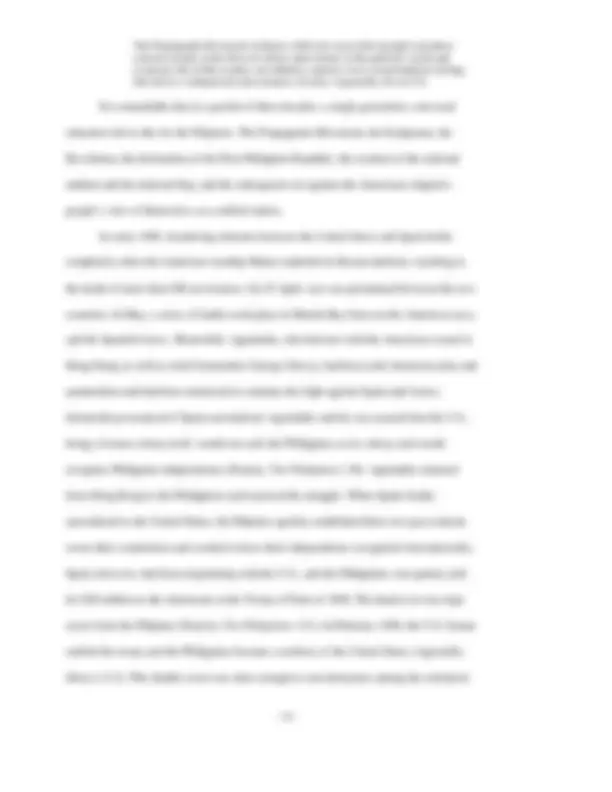
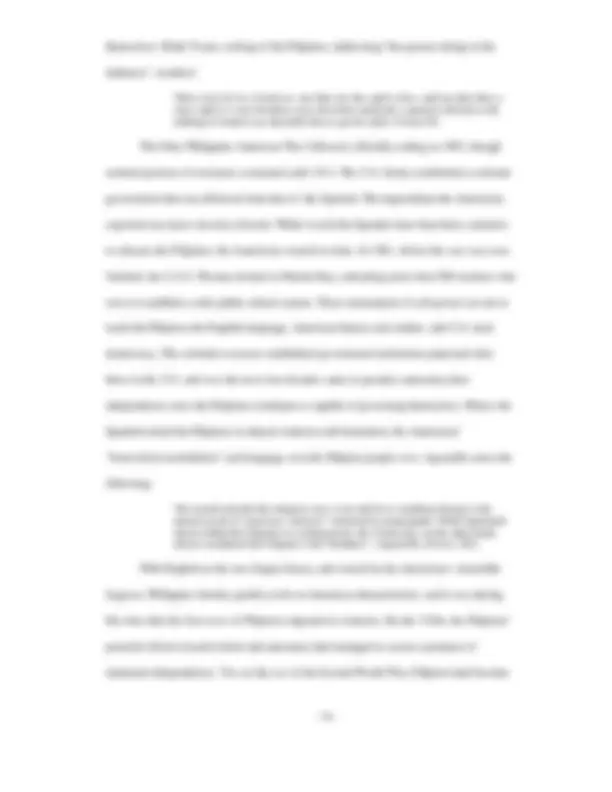
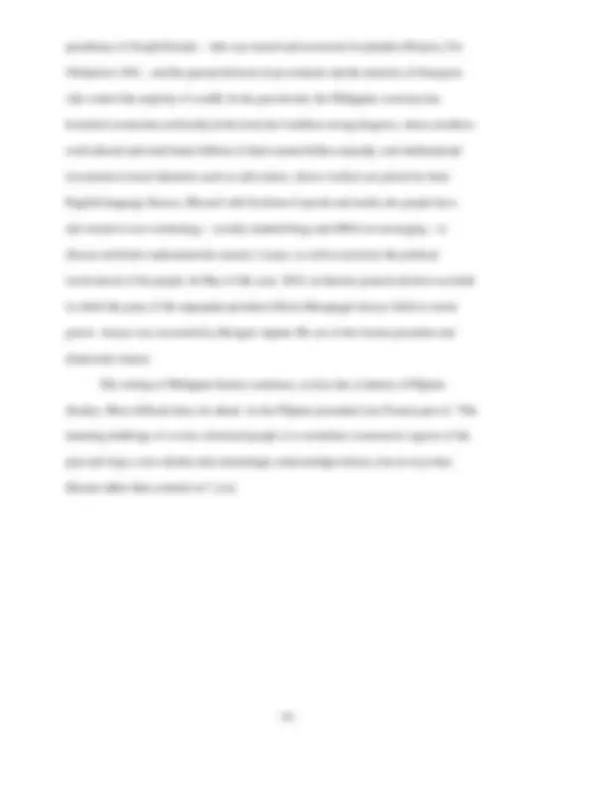
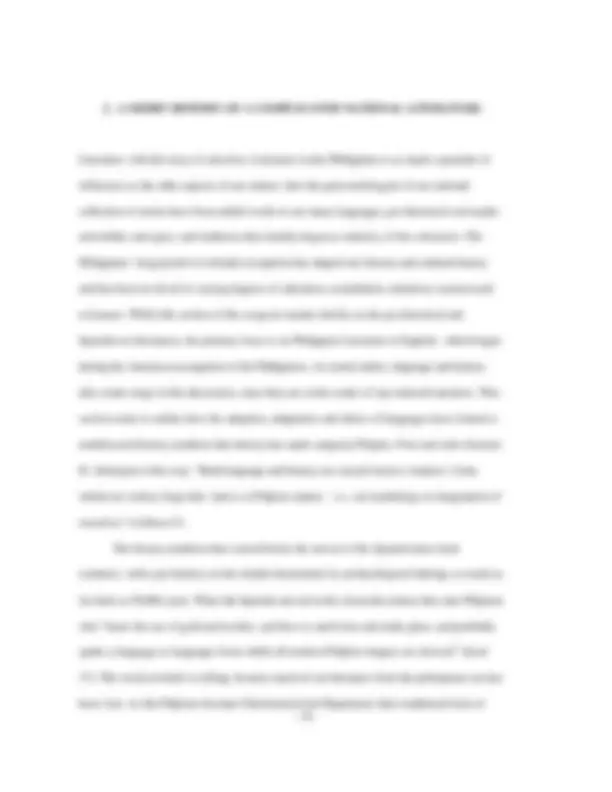
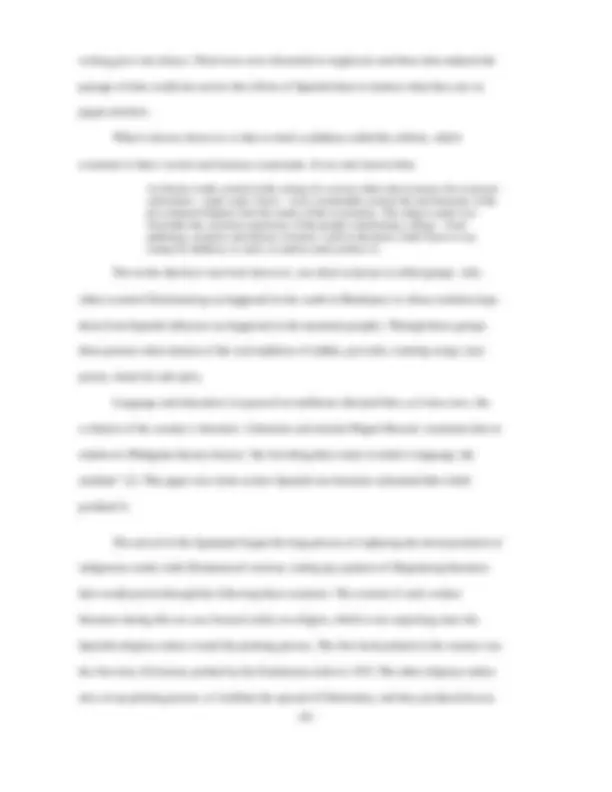
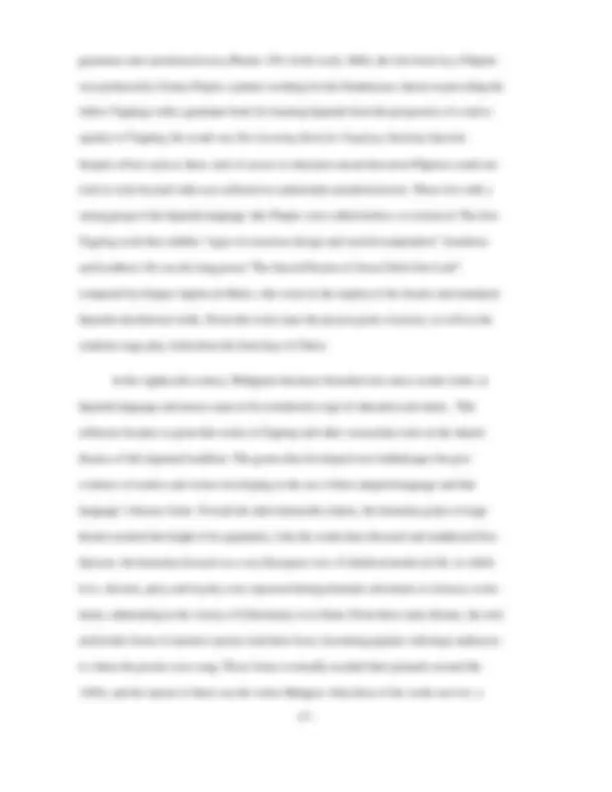
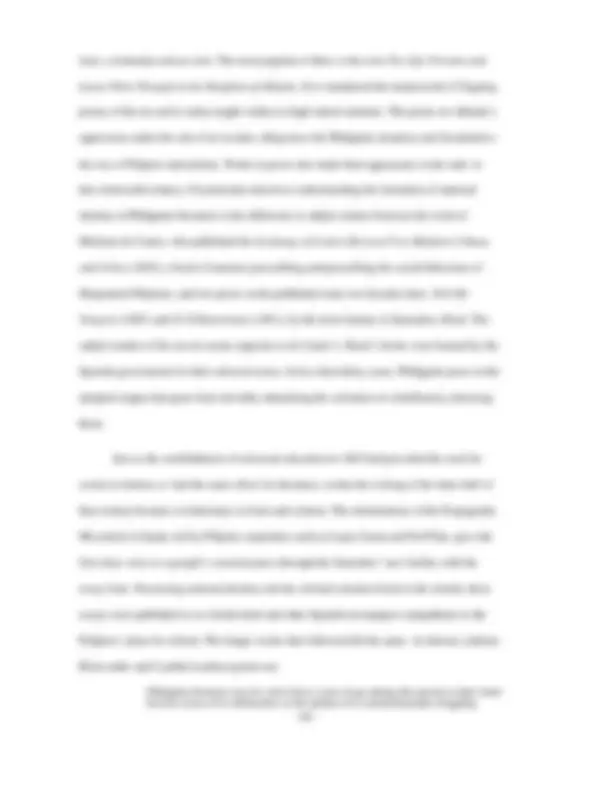
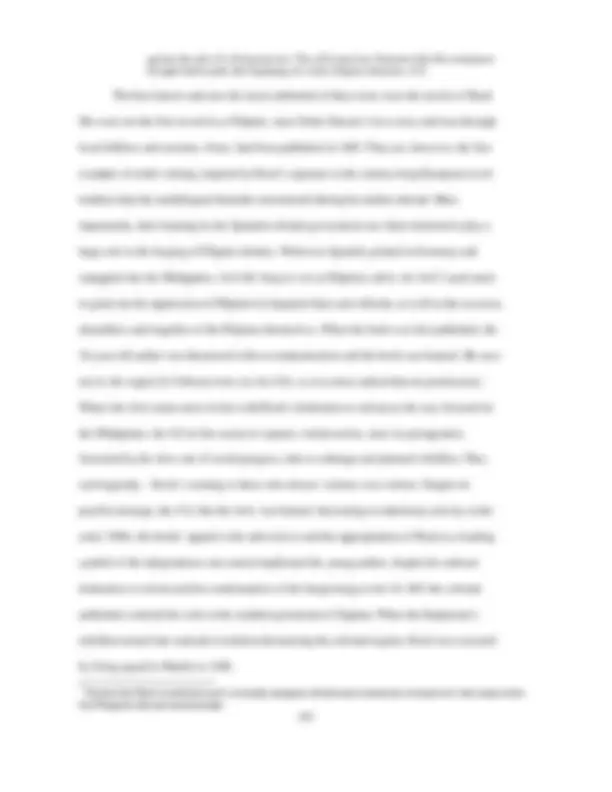
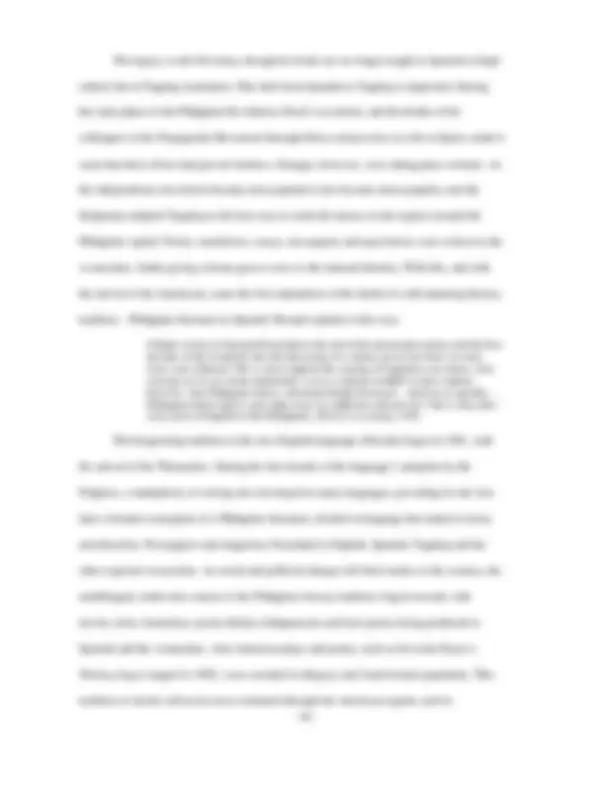
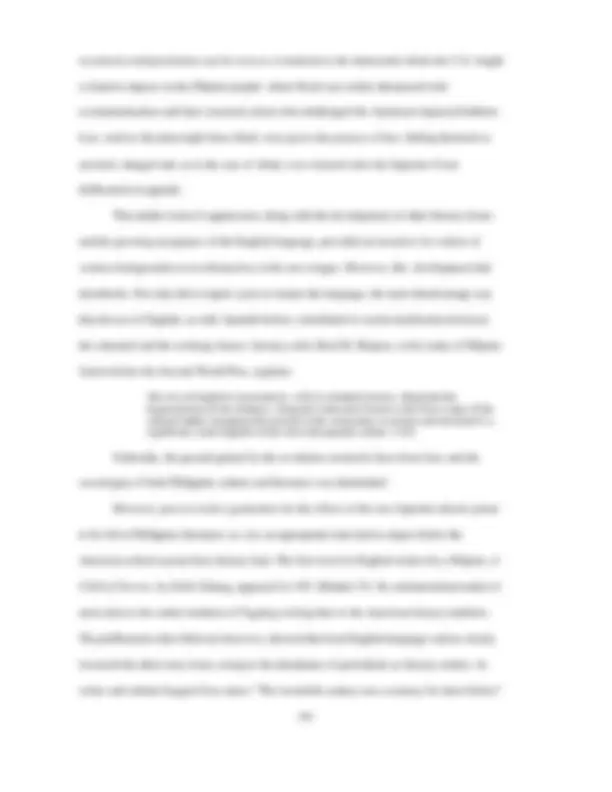
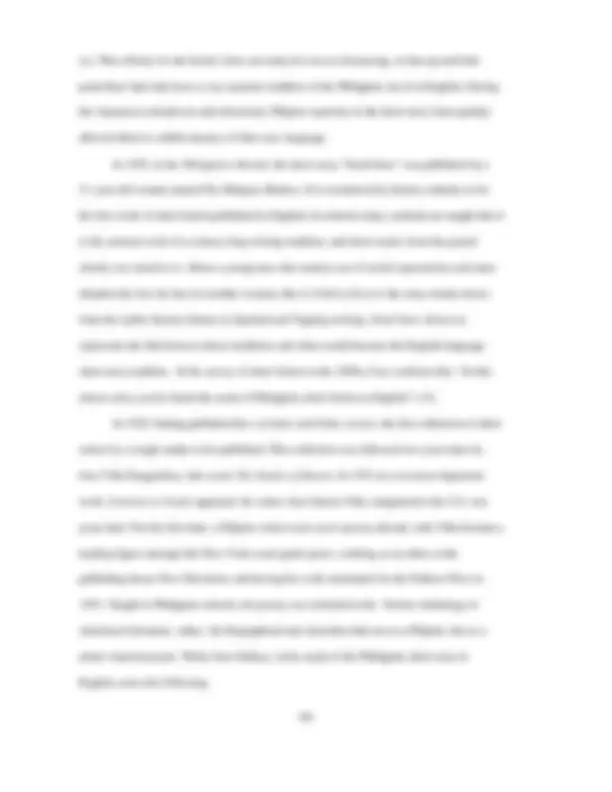
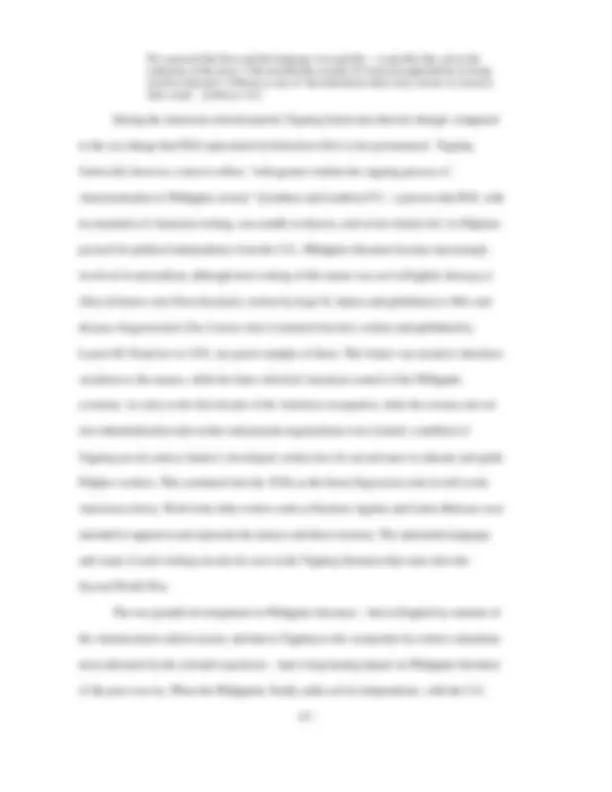
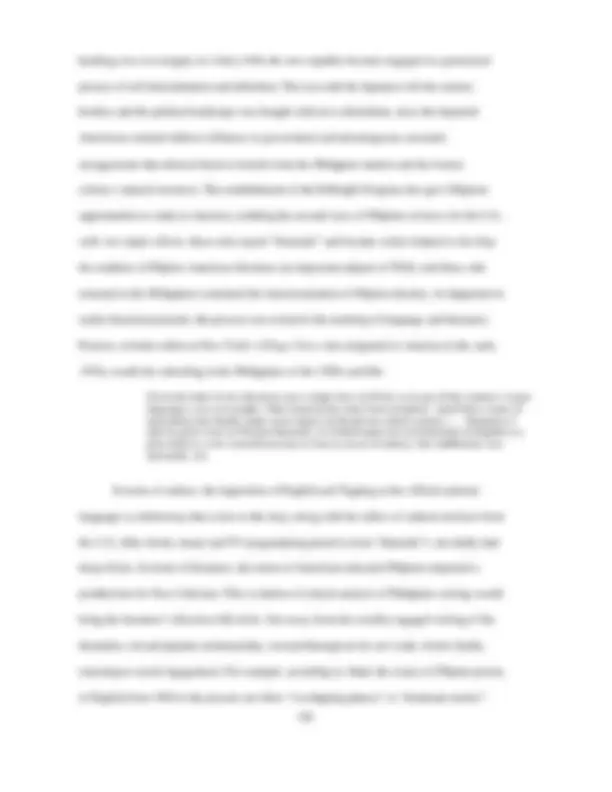
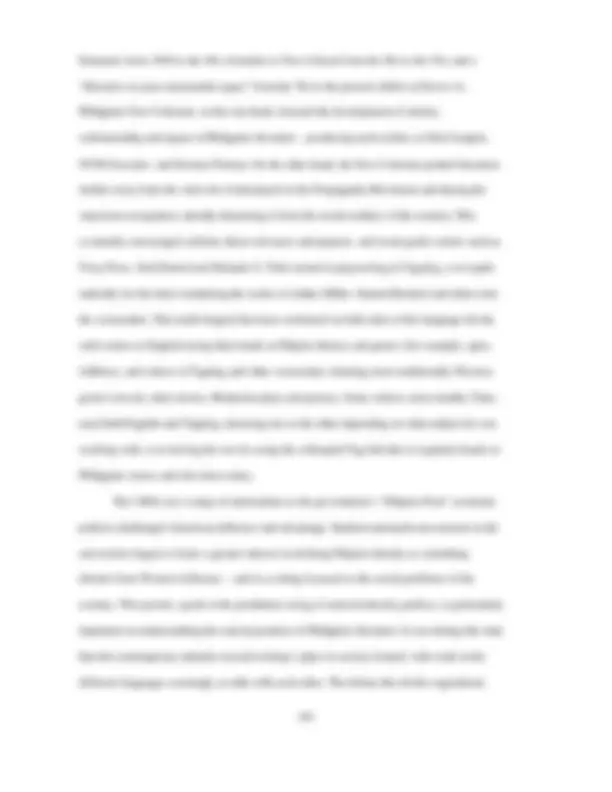
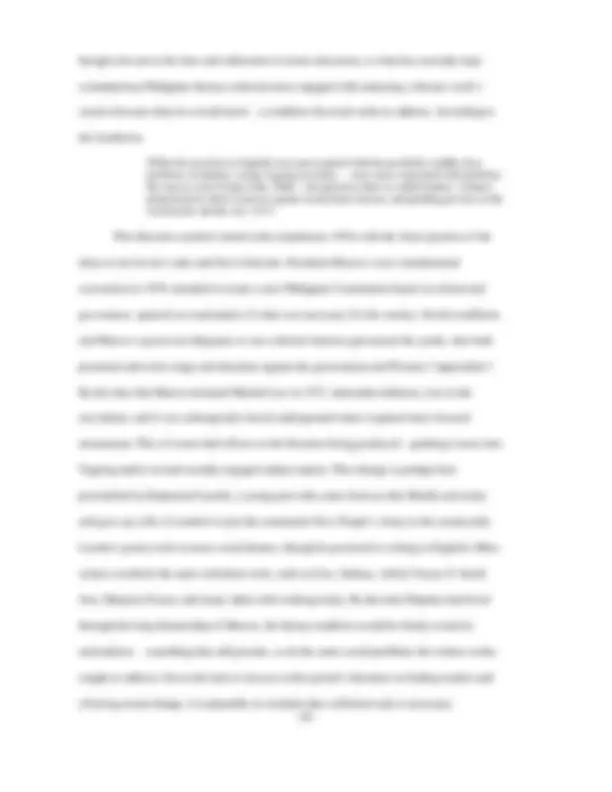
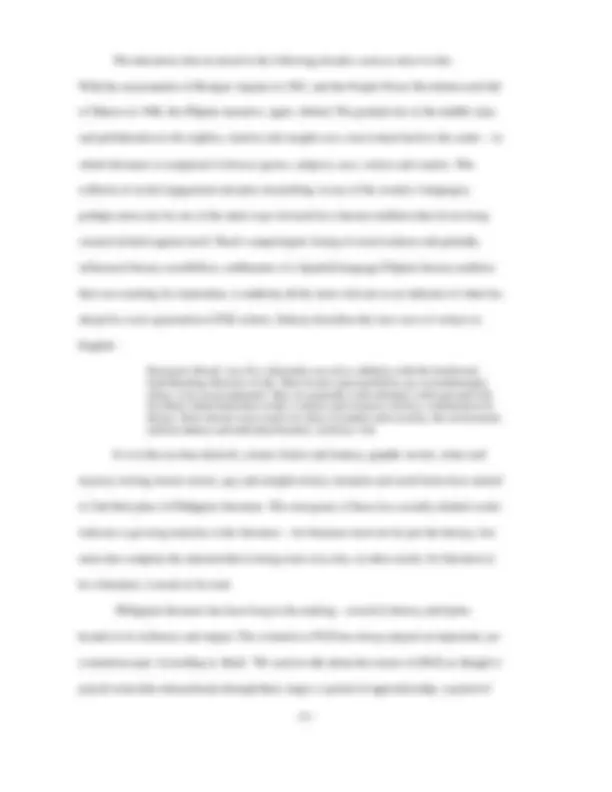
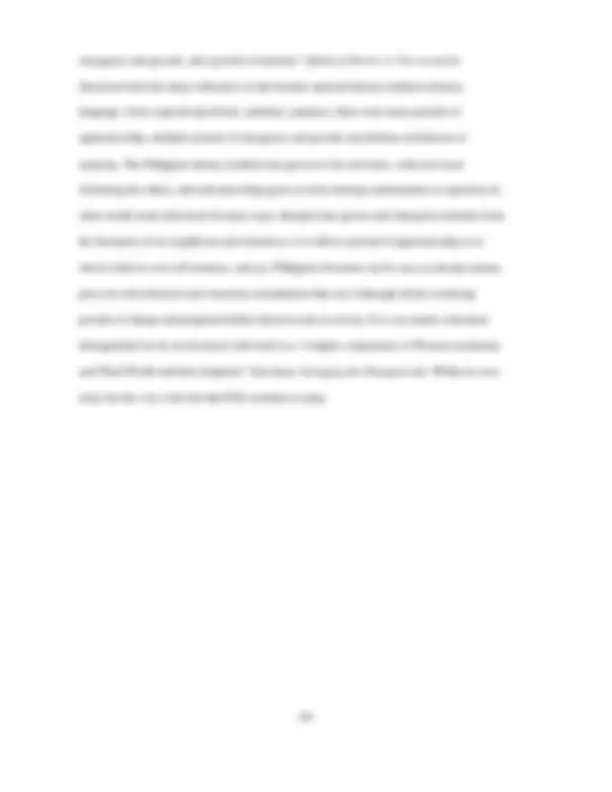
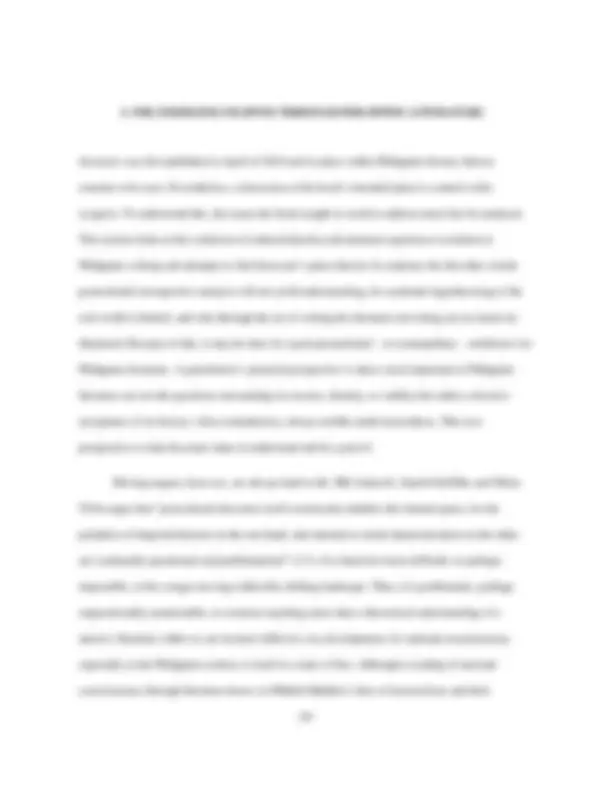
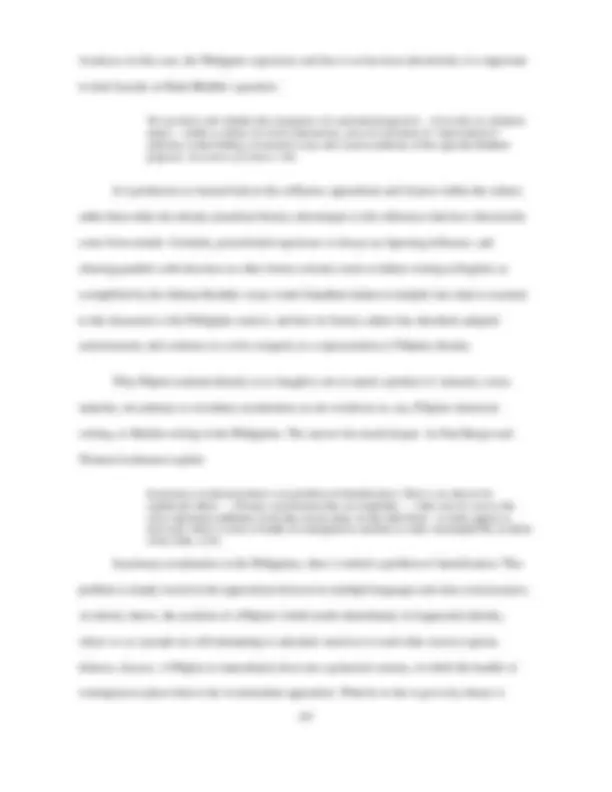
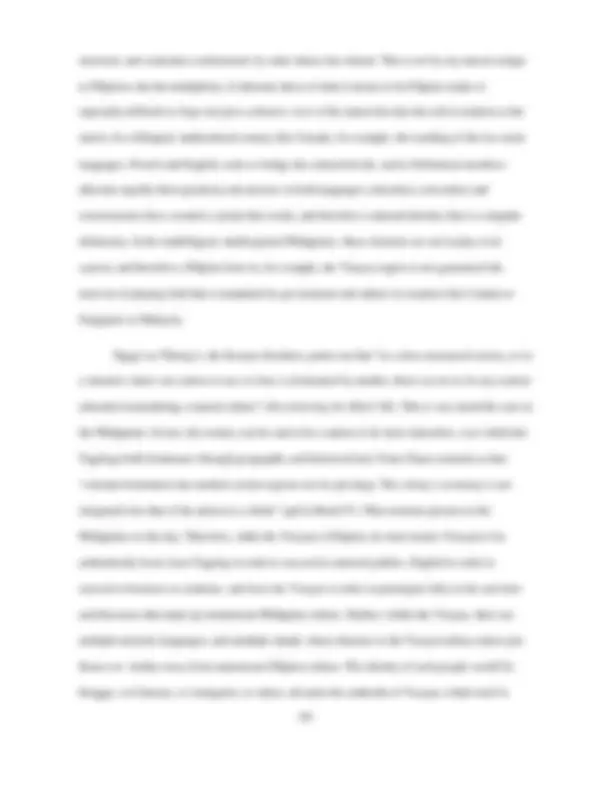
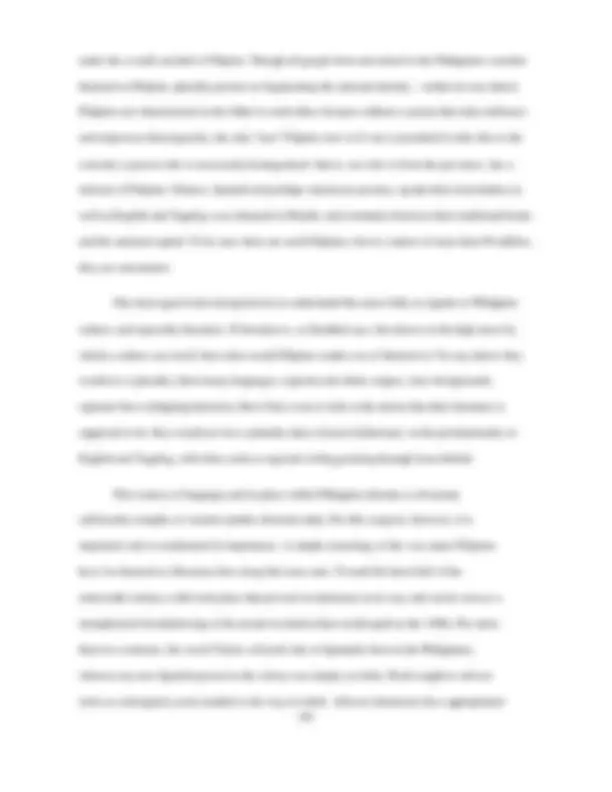
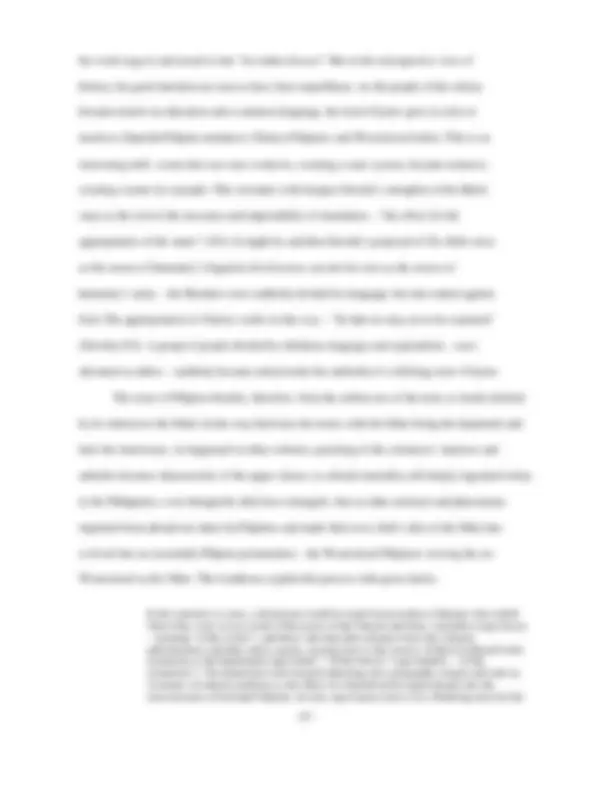
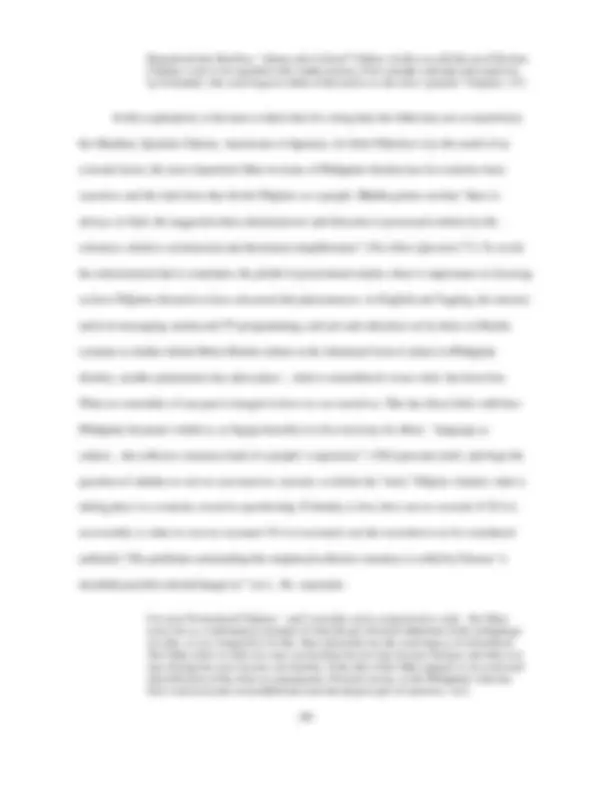
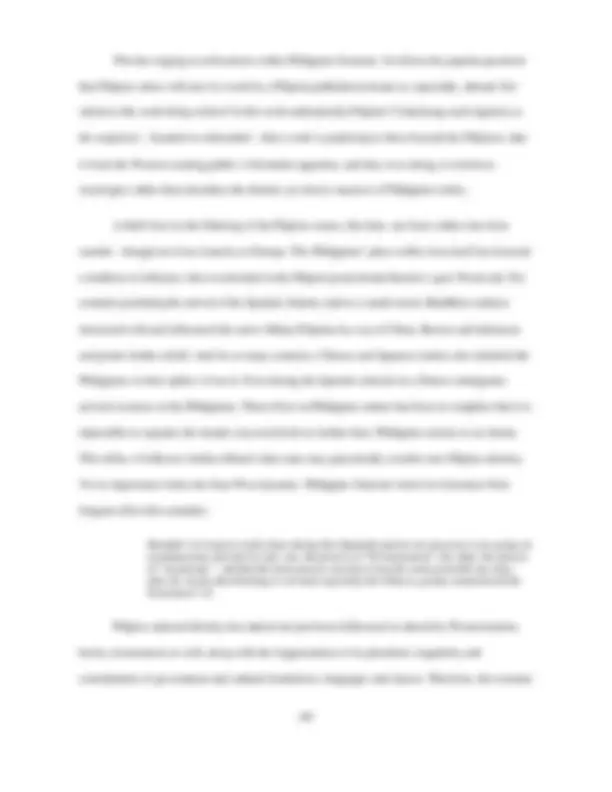
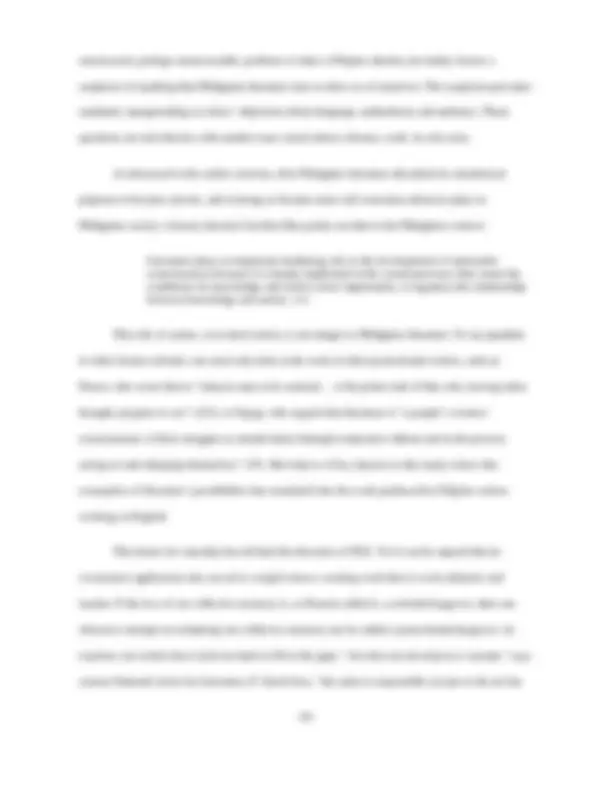
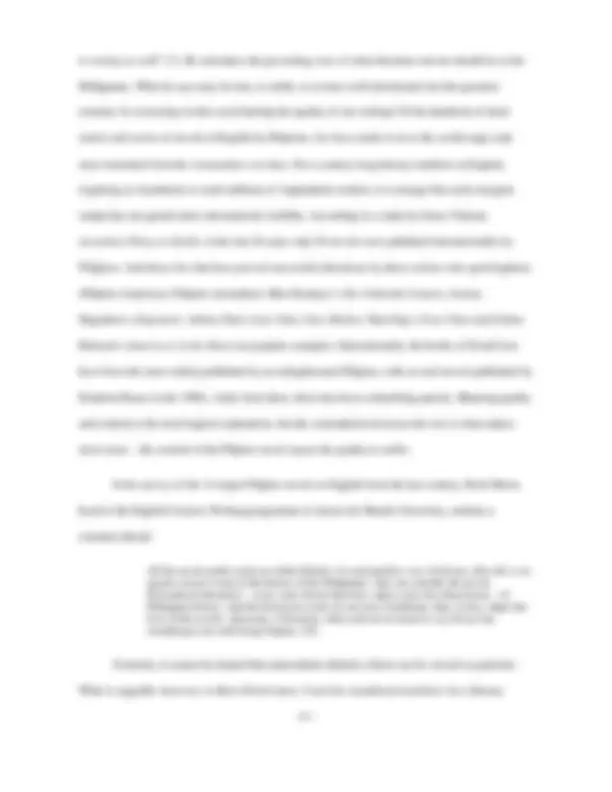
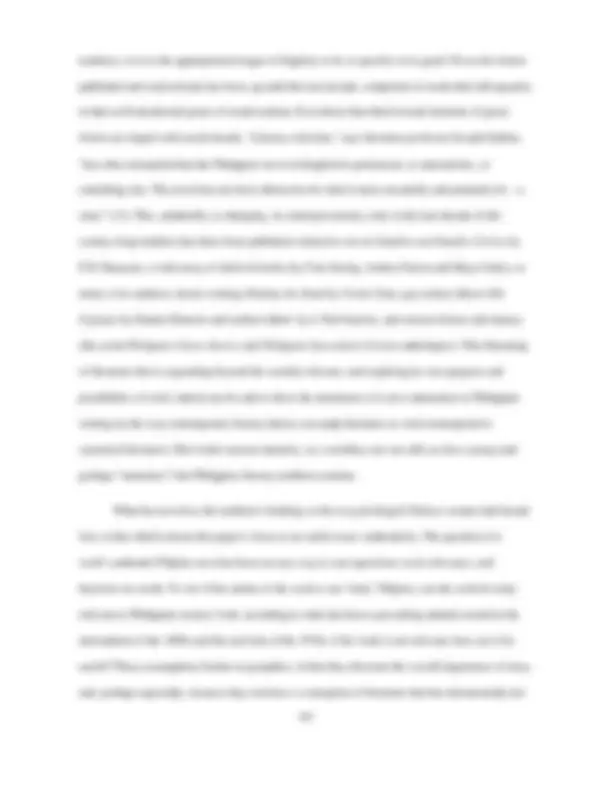
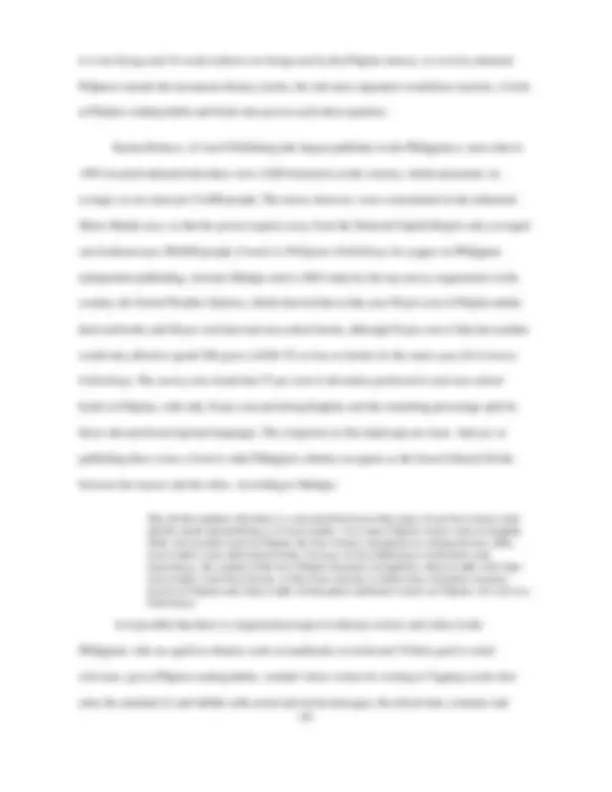
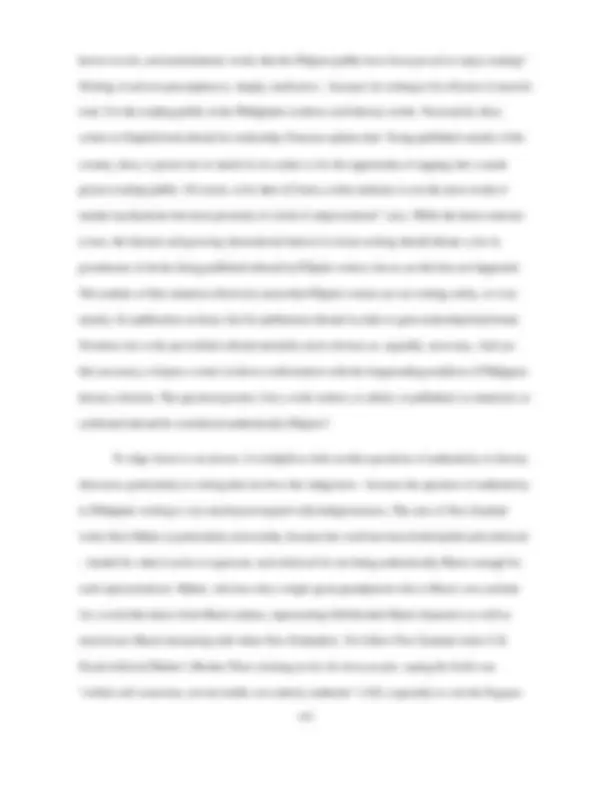
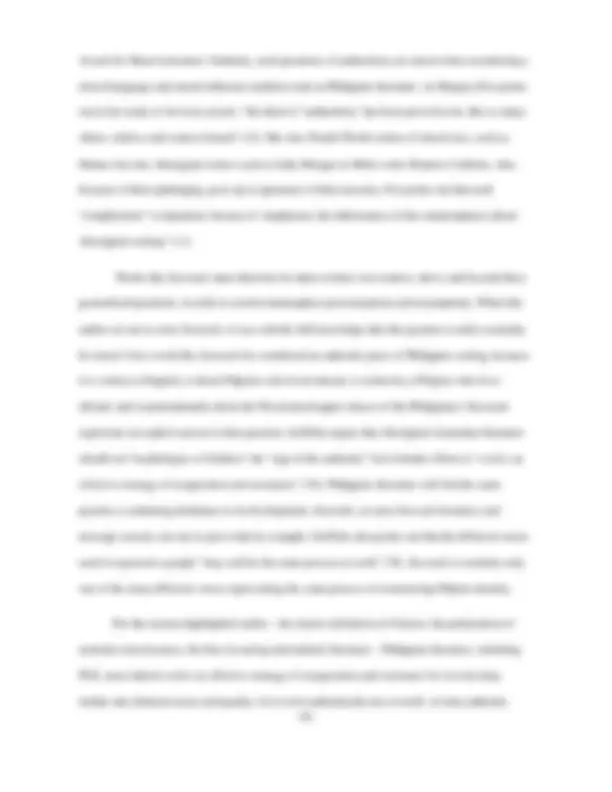
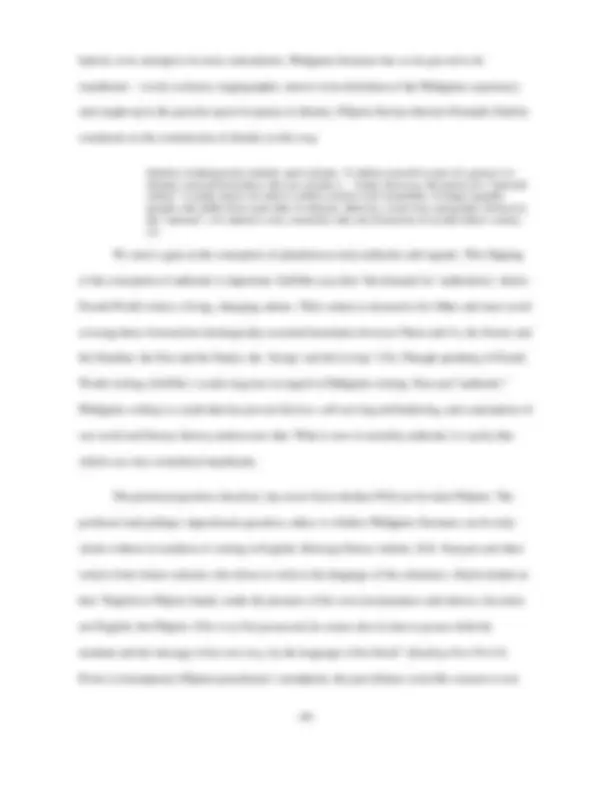
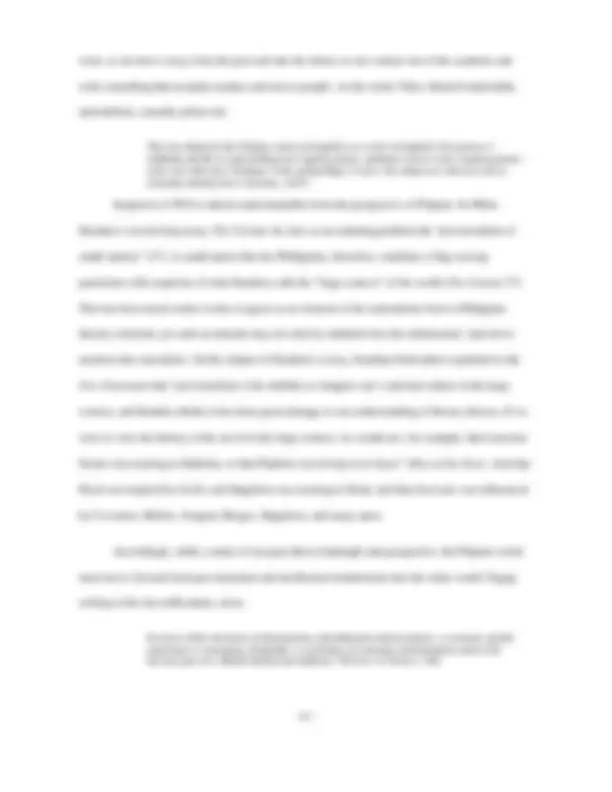
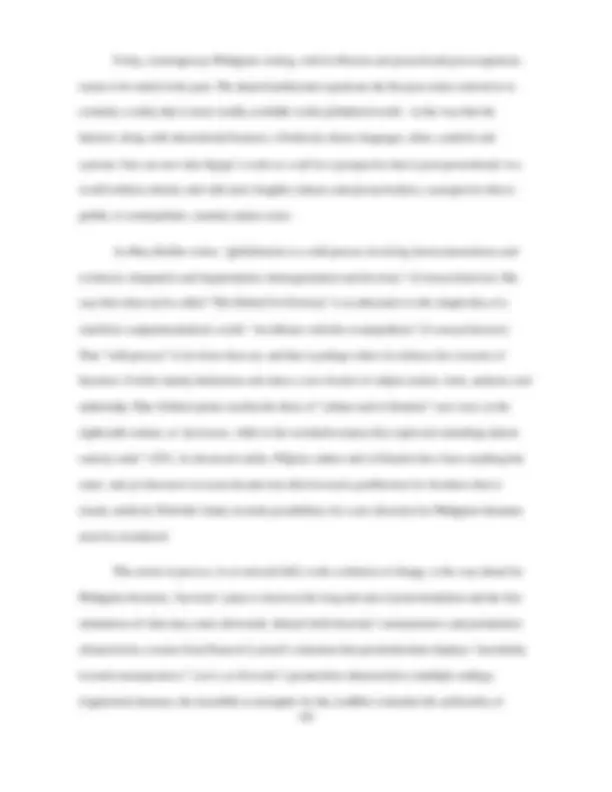
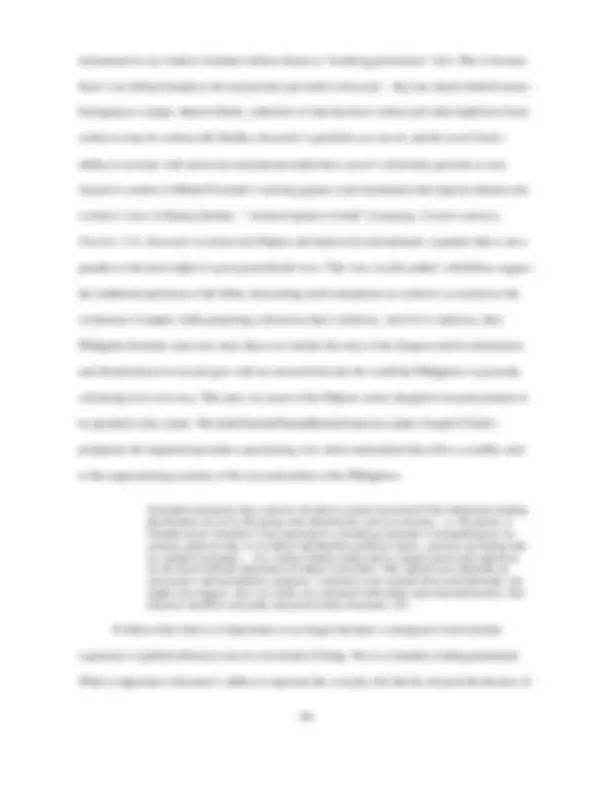
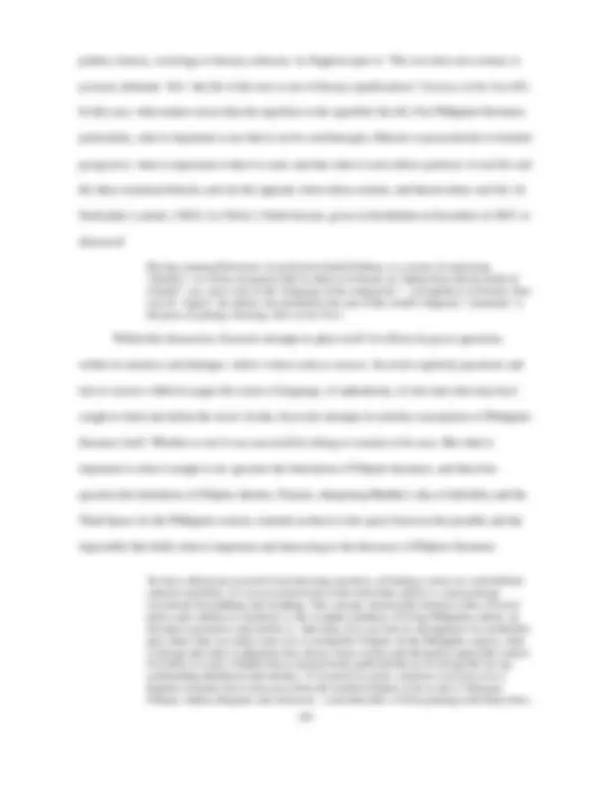
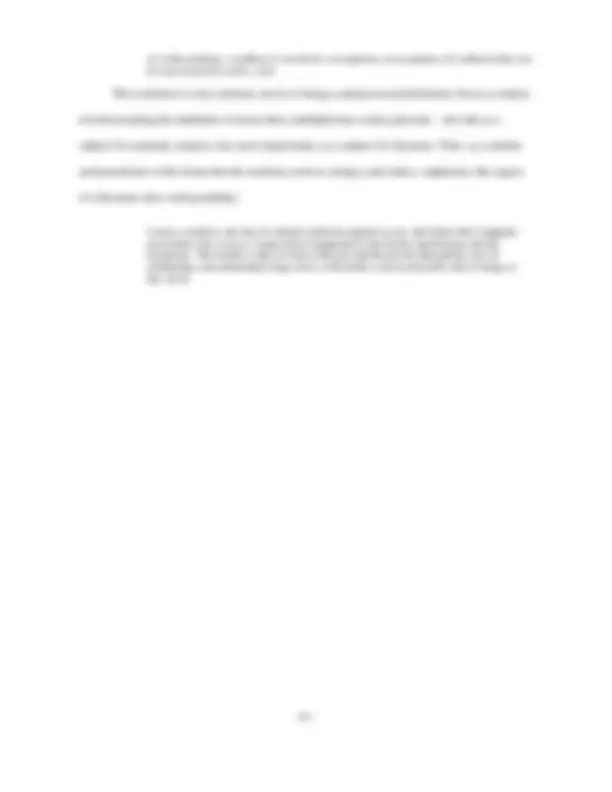
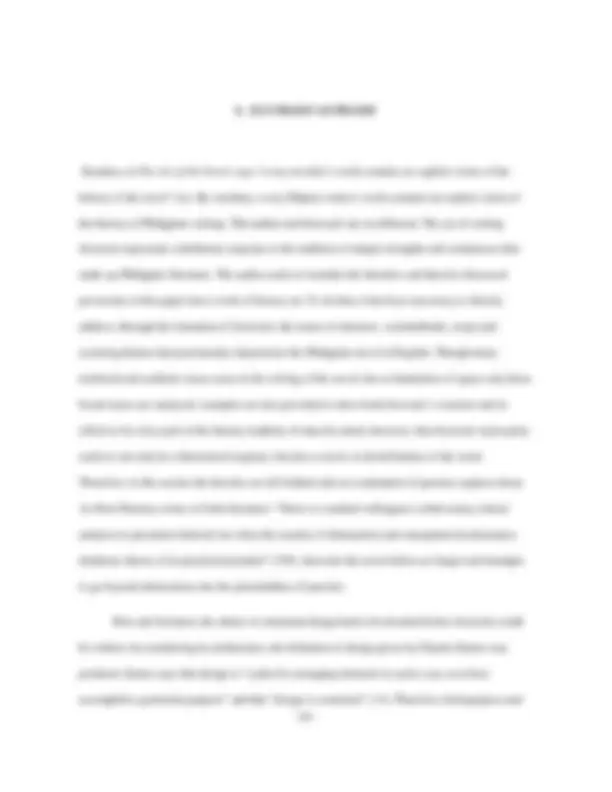
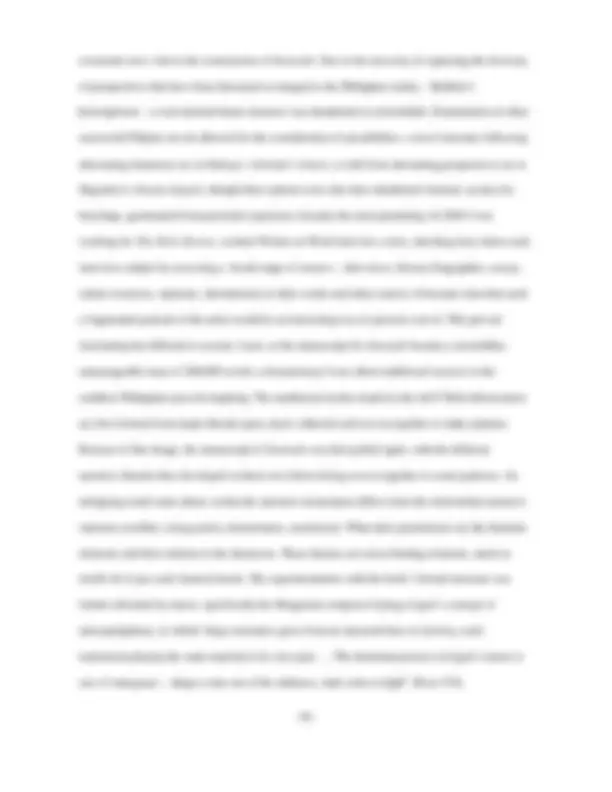
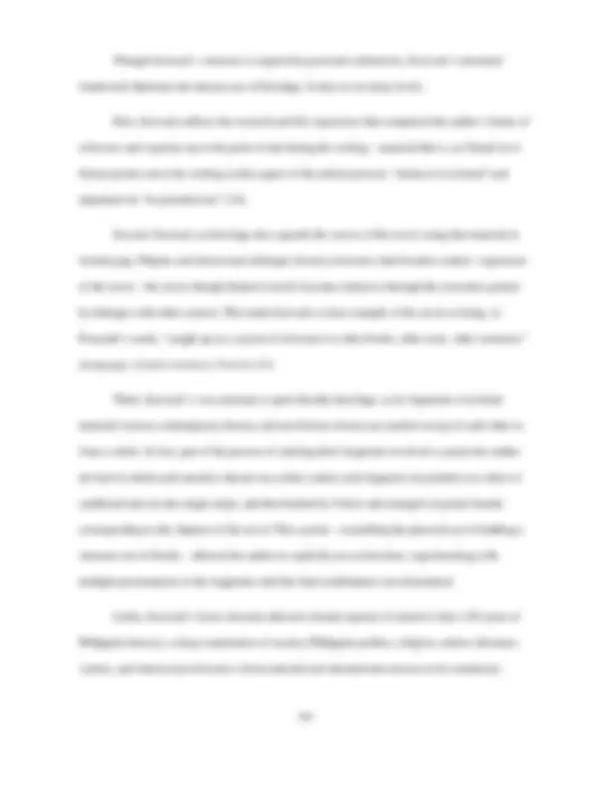
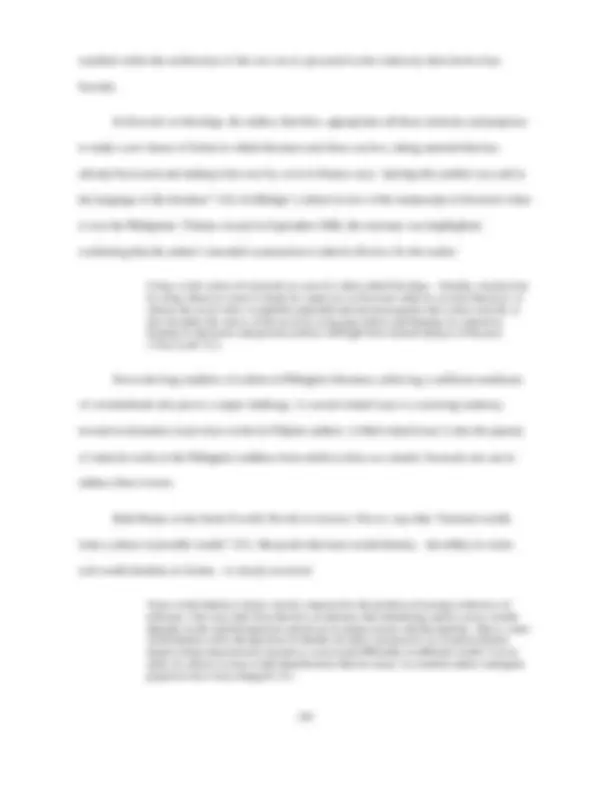
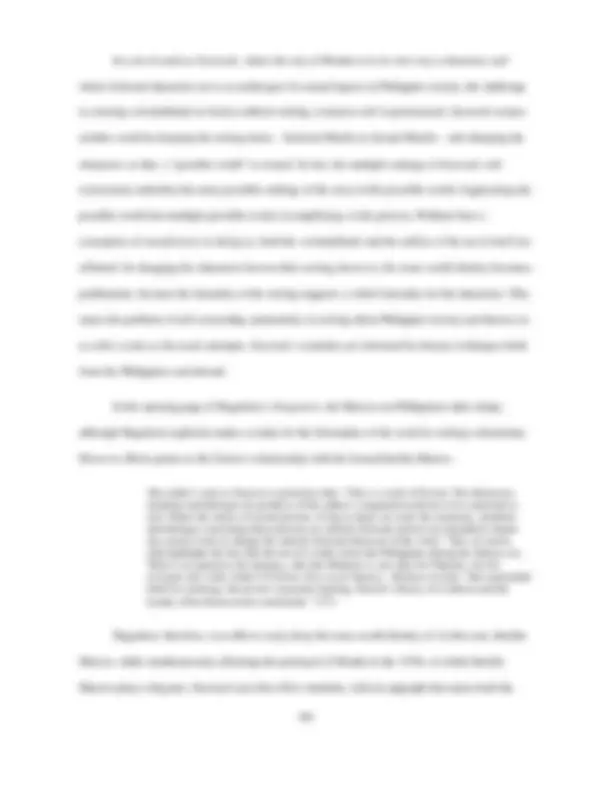
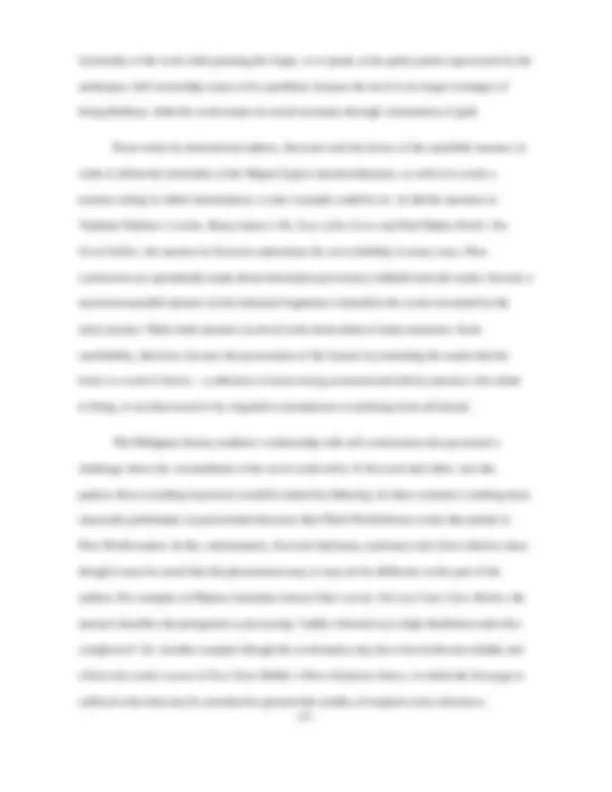
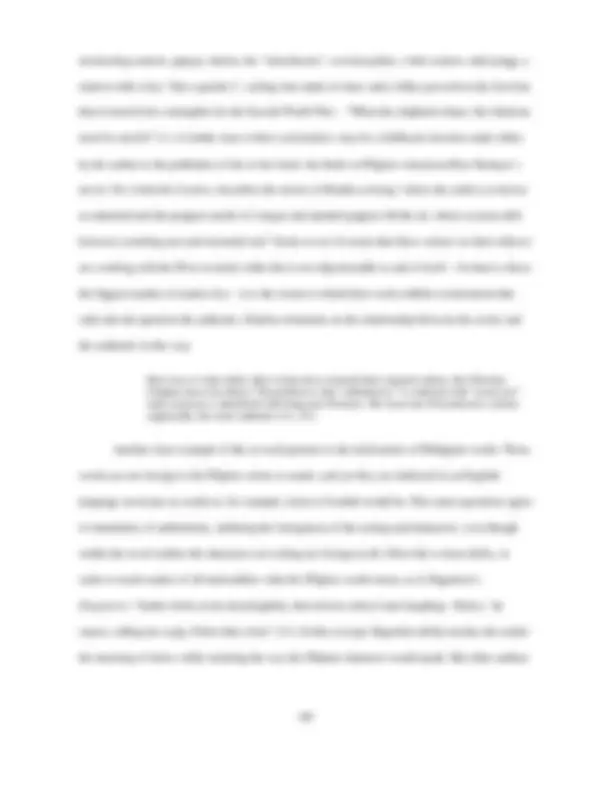
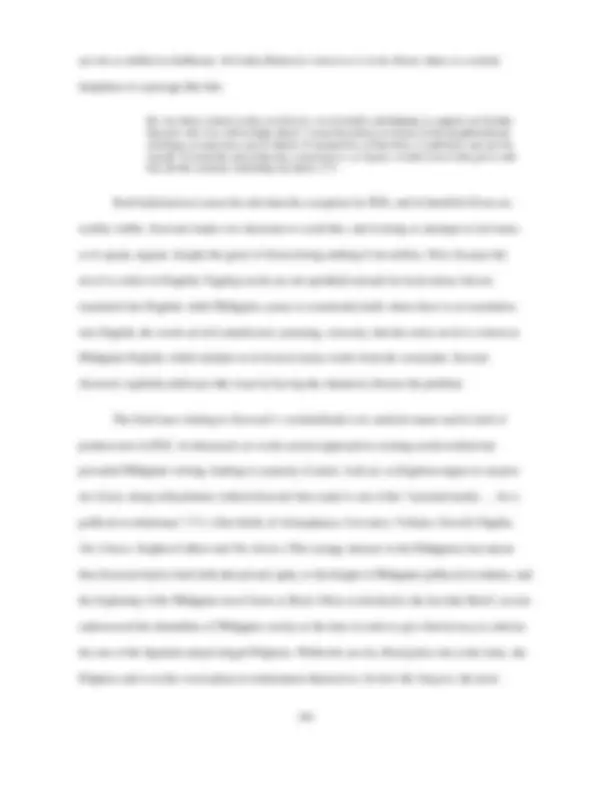
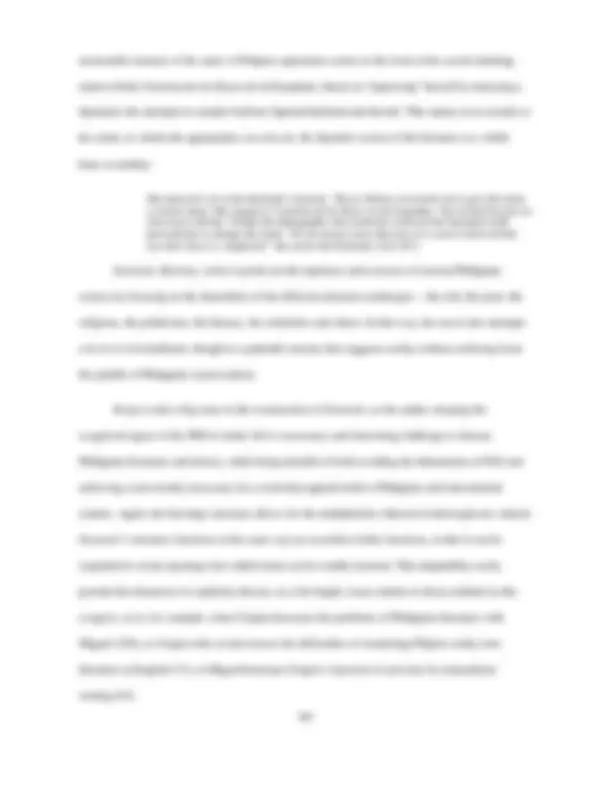
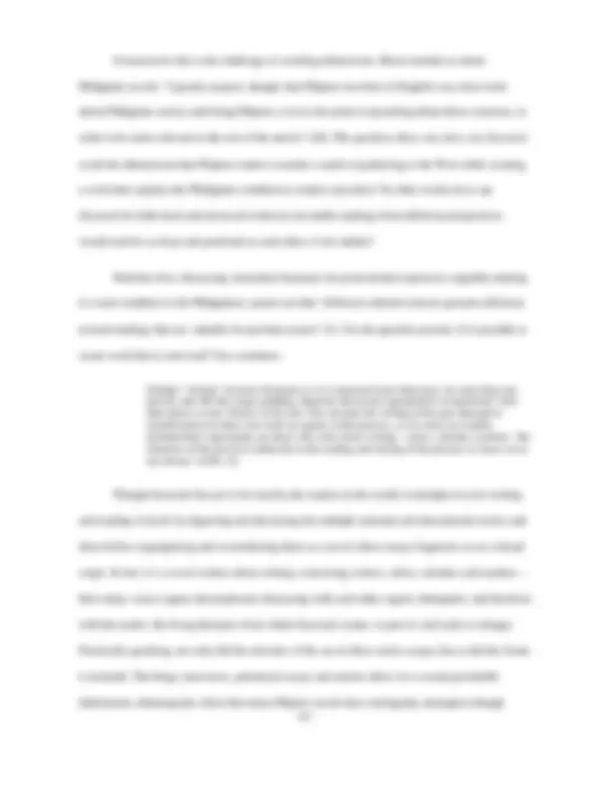
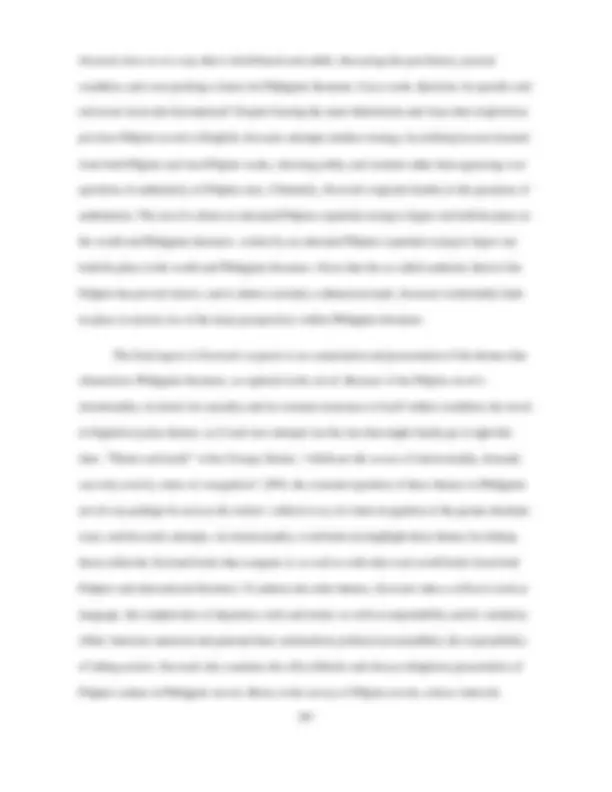
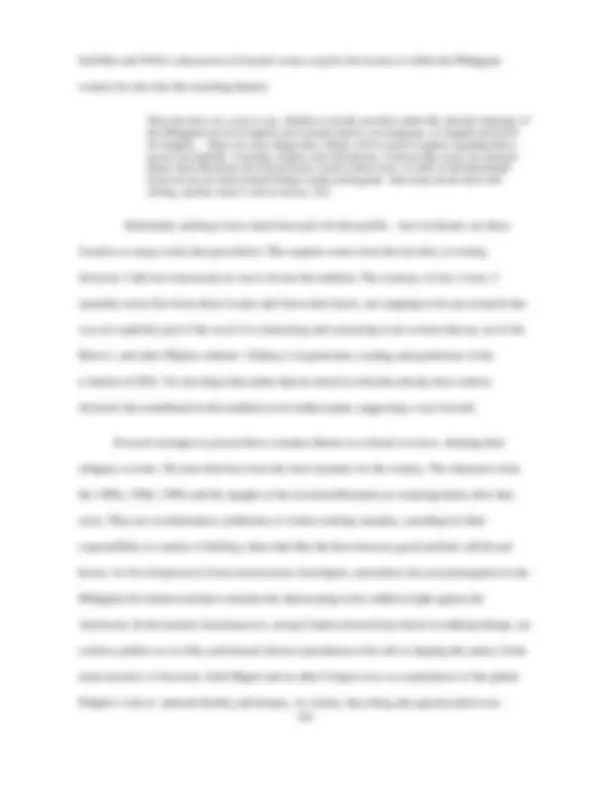
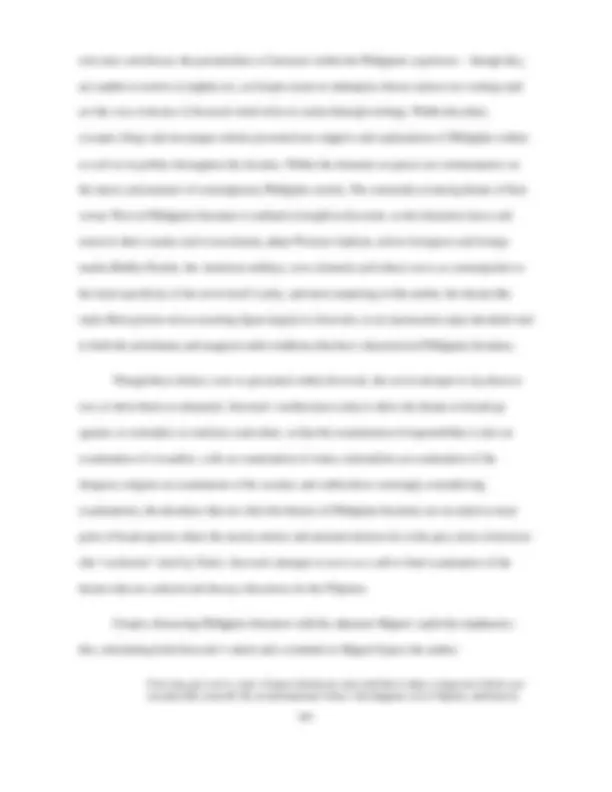
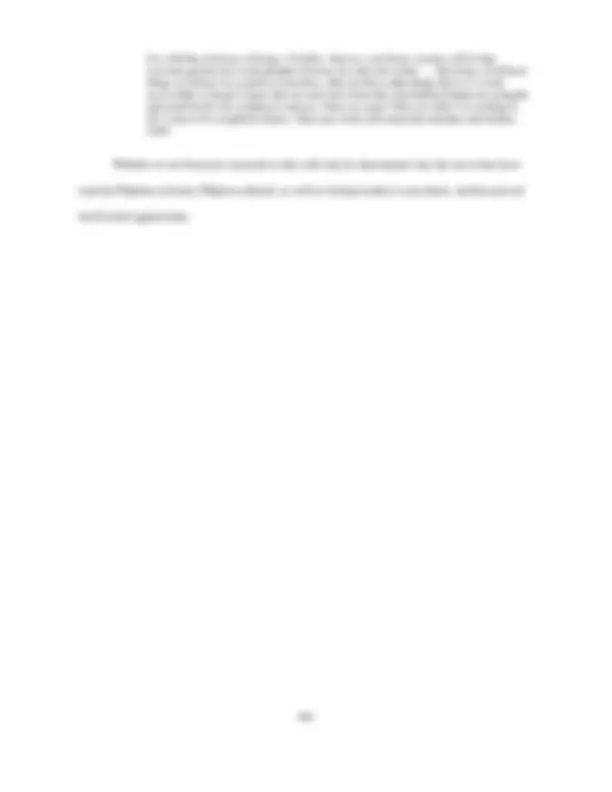
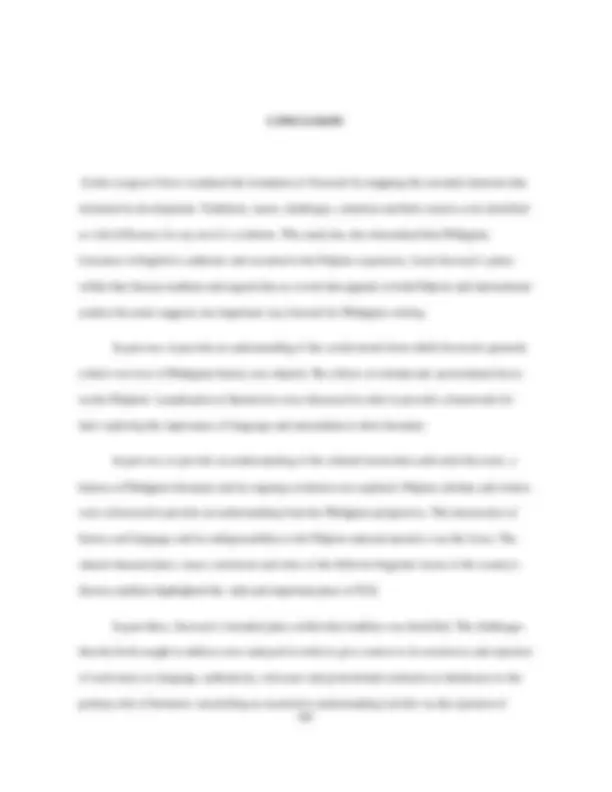
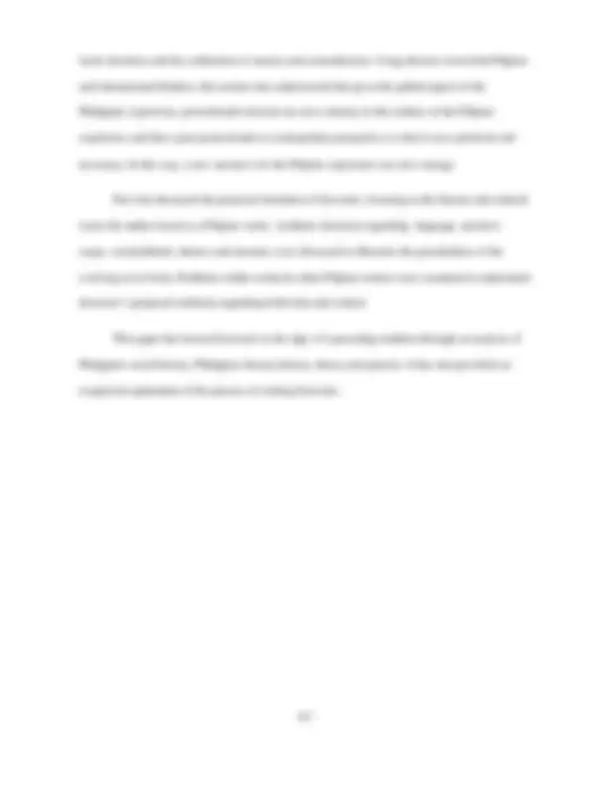
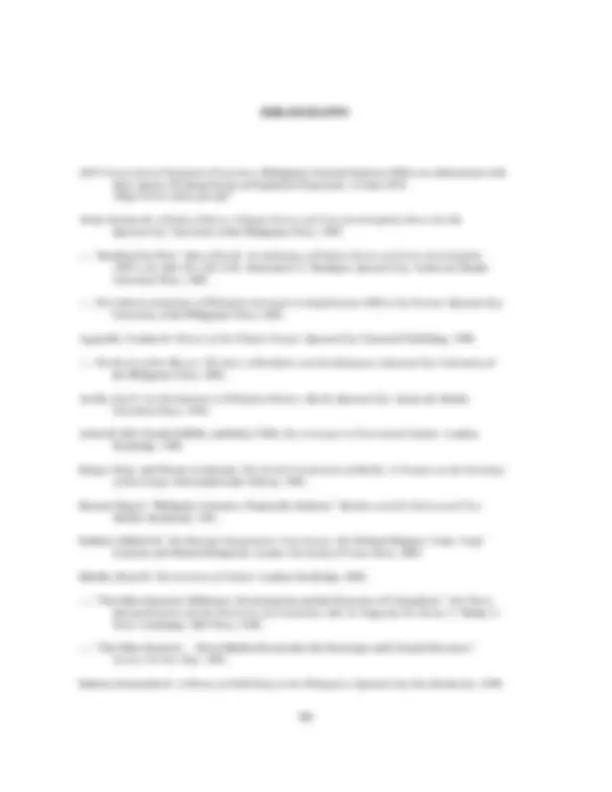
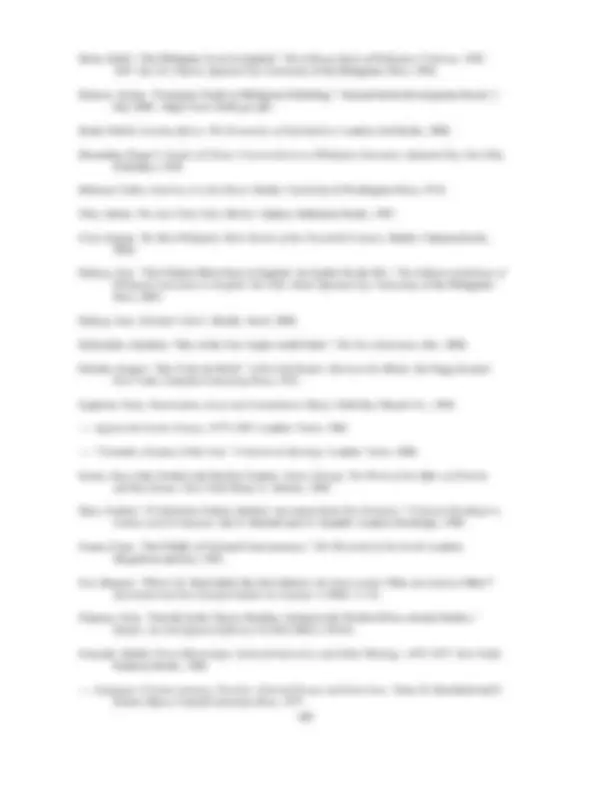
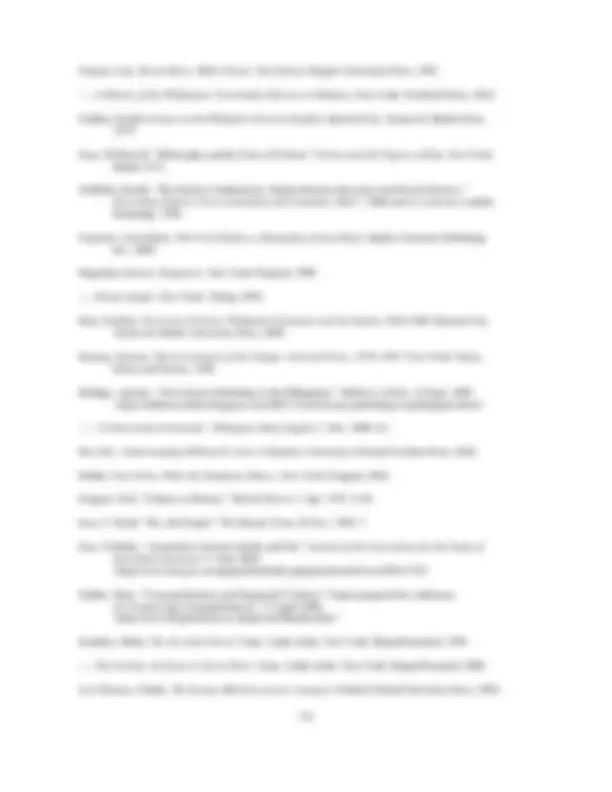
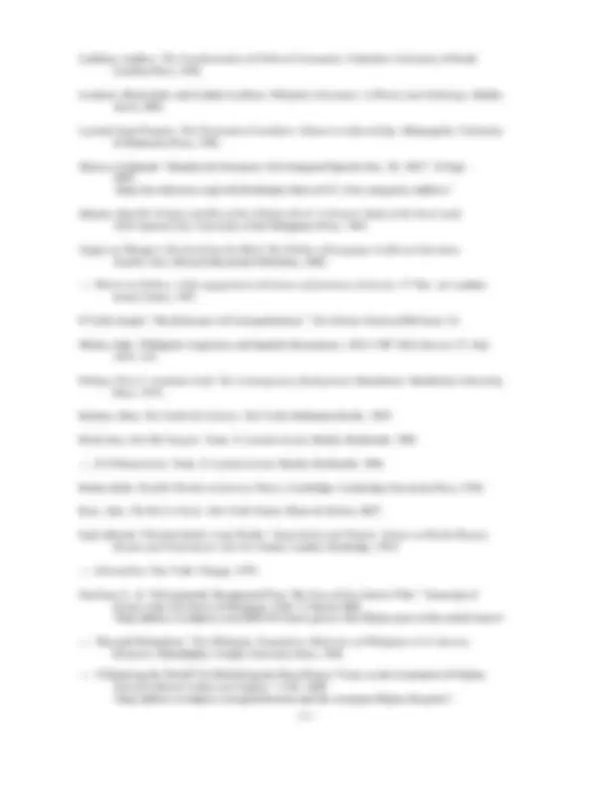
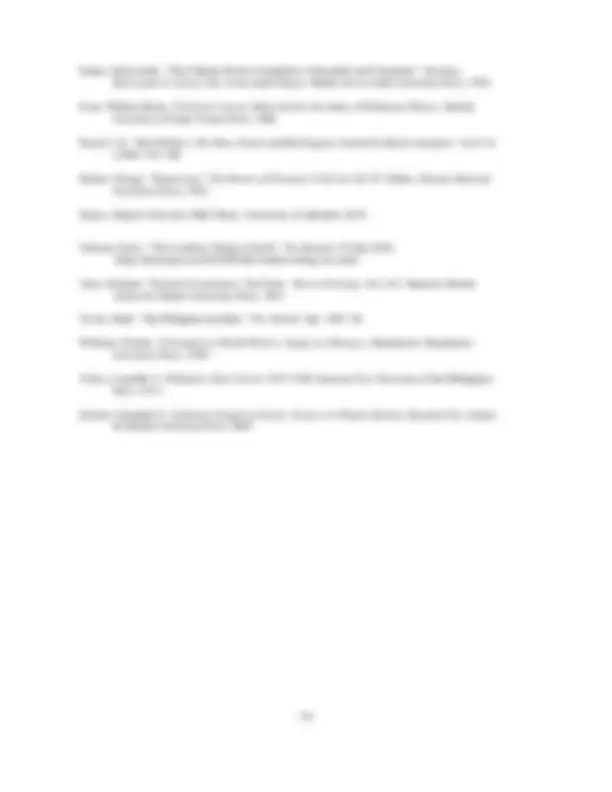


Study with the several resources on Docsity

Earn points by helping other students or get them with a premium plan


Prepare for your exams
Study with the several resources on Docsity

Earn points to download
Earn points by helping other students or get them with a premium plan
Community
Ask the community for help and clear up your study doubts
Discover the best universities in your country according to Docsity users
Free resources
Download our free guides on studying techniques, anxiety management strategies, and thesis advice from Docsity tutors
The development, challenges, and limitations of Philippine literature, with a particular focus on English fiction and its relationship with Philippine society. The novel 'Ilustrado' and its accompanying exegesis 'Autoplagiarist' are used as case studies to discuss issues of authenticity, relevance, language, thematic recurrence, and meta-narrative. The document also touches upon the impact of societal forces on Philippine literature and culture.
What you will learn
Typology: Summaries
1 / 72

This page cannot be seen from the preview
Don't miss anything!

































































The novel, Ilustrado, and this exegesis Autoplagiarist, seek to create a clear understanding of the development, challenges and limitations of Philippine literature, with a focus on its fiction in English, and its relationship with Philippine society. They seek to demonstrate: that Philippine literature in English (PLE) is as Filipino as writing in the native languages; that in today’s world a novel can, and in many cases should, be rich enough to appeal to a local and international audience; and that Ilustrado fits comfortably within that tradition and points a way forward.
Ilustrado , the novel, was written expressly with the issues of Philippine literature and society in mind and addresses questions of authenticity, relevance, language, thematic recurrence, meta-narrative and the current place of PLE in international writing. Autoplagiarist , the exegesis, looks briefly at Philippine history and the societal forces that have acted on its culture, surveys Philippine literature with a focus on writing in English, examines the tradition and Ilustrado ’s place within it and finishes with a discussion of the novel Ilustrado and the creative issues it sought to address. Research and analysis conducted for Ilustrado and Autoplagiarist yielded clear patterns exhibiting the enduring effects of social and historical events upon the development of PLE. Further, recurring themes and issues Filipino writers regularly address in their work became apparent. From these, possible pathways into the future were posited for a tradition often weighed down by its past.
This thesis argues that inertia and rootedness have come about through the literary tradition’s preoccupation with authenticity, nationalism, causality, didacticism and angst. It also attempts to demonstrate how Ilustrado faced these challenges within the novel’s implicit and explicit exploration of structure, verisimilitude, scope and the recurring themes that persistently characterise the Philippine novel in English.
I would like to express my gratitude to my PhD supervisors, Dianne Schwerdt, Brian Castro, Nicholas Jose and Ben Marcus, for all their guidance in the crafting of my novel and exegesis, as well as their help in finding my way through the often labyrinthine corridors of academia.
I would also like to acknowledge the vital research on Philippine literature, particularly Philippine Literature in English, undertaken by all the scholars cited within this paper. I am indebted to them for their seminal contributions to the burgeoning literary tradition from which I come.
I also gratefully acknowledge the judges of the Palanca Award and the Man Asian Literary Prize, who saw the merit in Ilustrado before it was fully completed.
This exegesis takes its title from the autobiography of Ilustrado ’s main character because it examines the relationship between the fact that served as the foundation for the novel and the fiction from which the book is made. This paper discusses the research that culminated in an understanding of the social and literary histories that were integral to Ilustrado ’s evolution. It also looks at the influence of precursors in fiction that led to the author’s aesthetic, narrative and thematic choices. Lastly, it locates Ilustrado ’s place within Philippine Literature in English (PLE) and presents the theories that informed the novel’s intentions.
For a better understanding of the mosaic-like fragmentation of Ilustrado , and its process of creation, this exegesis is as straightforward and methodological as possible. It adheres to the notion that the best way to explain something complicated is to do so simply. It seeks to underscore: that PLE is as Filipino as the literature in the native languages; that in today’s globalised world a work can, and in many cases should, be rich enough to appeal to a local and international audience; and that Ilustrado attempts to point a way forward from the postcolonial issues that have characterised PLE.
This exegesis has been structured into four sections. The first is an overview of Philippine history, an understanding of which is integral to the arguments that follow in this paper. The second looks at Philippine literature, particularly PLE, analysing how choices of language have influenced the formation of the country’s literature, thereby helping to shape Philippine identity. An examination of the socio-historical background provides an overview of antecedent literary traditions, revealing the chronotopic intersections that make up Philippine
Filipino culture is a singular pastiche of Malay, Chinese, Spanish, American, Catholic, Islamic, animist, ancient and modern influences. Similarly, Philippine literature is a singular pastiche of historical influences, informed by 377 years under Spanish rule, 41 years under America’s “benevolent assimilation”, four years under Japanese occupation and many more years of indirect influence from neighbours, immigrants, returning members of the diaspora and the forces of twentieth-century globalisation. As an archipelago of more than 7,100 islands, this melting-pot is made even more flavourful by the fact that the 94 million Filipinos (National Statistics Office) come from various ethnic and regional backgrounds and speak more than 170 native dialects, with English and Pilipino – Tagalog – as the official national languages. The effect of this shared experience on literary history will be examined later; this section provides the foundation for that discussion by focusing on the country’s social history that started with the Spanish conquest of the Philippines, continued through the colonial and postcolonial influence of the Americans and developed during the six decades since independence. Cognisance of this history is essential for an understanding of Ilustrado ’s challenges, intentions and scope; this section provides necessary background information and is not intended as an analysis of the history of the country. In the sixteenth century a confluence in Europe of religious zeal, advances in maritime technology and the profitability of trade in goods acquired from Asia resulted in a journey that changed the history of the people who became known as Filipinos. The 1519 expedition of Ferdinand Magellan, the Portuguese mariner in the service of Spain, sailed westward from Europe to find a shorter route to the Spice Islands (the Moluccas, in today’s Indonesia). His five ships and 235 men sailed around South America, across the
Pacific Ocean and reached the Philippines on 17 March 1521 (Agoncillo, History 71). Magellan’s role in the voyage ended when he was killed in a battle with the tribal chieftain Lapulapu on the island of Mactan, though one ship sailed by 19 Europeans and four Malays eventually returned home, completing the world’s first circumnavigation and confirming to Europe the vastness of the Pacific Ocean, the roundness of the earth and the existence of the archipelago that a later conquistador – Miguel Lopez de Legazpi – would, in 1565, name and establish for King Philip II of Spain. The Spanish settlement of the Philippines has been chronicled as a long period under Imperial Spain in which three forces played the most important parts: rich in resources, the archipelago had clear economic value; situated on the doorstep of Asia, it had strategic worth; and with a large so-called heathen population, it was ripe for proselytizing and conversion by Spanish Catholic friars. Conquest in terms of these three characteristics would later be reprised by the Americans and Japanese, in their own ways. The archipelago’s regional divisions and its many dialects worked against the unity of the peoples of the islands, making it easier for Spain to subjugate them and govern. This period of Philippine colonial history, though long and complicated, is, in the formation of national identity, arguably less eventful in comparison with the period straddling the Spanish departure and the American arrival. Two related elements, however, are highlighted as integral to this paper – language and education. For most of their tenure, the Spanish governed with as little contact with the native indios*^ as was workable. Despite the fact that their power was meant to be derived from both church and state, it transpired that the only Spaniards with regular contact with the broader indigenous population were priests or friars of local parishes. Schools were intended to be built for the general population but, aside from the universities in the main
describes as “speaking of the entry into full self-realisation of a unitary subject known as the people” (9). The burgeoning Filipino identity came into being on two levels. At the national level, the schools provided either the foundation or full education for key local figures in the Philippine Revolution of 1896, such as, to name but three, Andres Bonifacio (who founded the Katipunan, a secret secessionist society), Apolinario Mabini (who later drafted the first Philippine constitution and was known as the “Brains of the Revolution”), and Emilio Aguinaldo (who led the revolution and became the new nation’s first president). On the international level, the school system allowed some Filipino students to further their education abroad, exposing them to liberal ideas, and they formed the group of thinkers, activists and revolutionaries we now know today as the ilustrados ( ilustrado means enlightened in Spanish). Among these are: Jose Rizal (the national hero, polymath and writer of the two most revered Philippine novels, both written in Spanish, Noli Me Tangere and El Filibusterismo ), whose execution in 1896 by the Spanish fuelled the revolution; Graciano Lopez Jaena (known as “The Prince of Filipino Orators”), who founded the Propaganda Movement in Spain which lobbied for reforms for the Spanish government in the Philippines; Marcelo H. Del Pilar (known as “The Great Propagandist”), who edited La Solidaridad , the main newspaper of the movement; and Antonio Luna, whose study of tactics and combat led to his post as a general and chief of war operations for the revolutionary army against the invading Americans, as well as his founding of the Academia Militar (which trained their forces). The common goals these figures worked toward was first reform, then, when calls for reform went ignored, revolution in 1896. Together the local organisers and those in Europe formed the first cohesive picture of Filipino identity. Ultimately, their efforts were to fail in everything except establishing a first sense of nationalism. As the historian Teodoro Agoncillo explains:
The Propaganda Movement in Spain, while not successful enough to produceconcrete results in the form of serious innovations in the political, social and economic life of the country, nevertheless started a wave of nationalistic feelingthat led to a widespread consciousness of unity. (Agoncillo, Revolt 33) It is remarkable that in a period of three decades, a single generation, universal education led to this for the Filipinos. The Propaganda Movement, the Katipunan, the Revolution, the declaration of the First Philippine Republic, the creation of the national anthem and the national flag, and the subsequent war against the Americans shaped a people’s view of themselves as a unified nation. In early 1898, foundering relations between the United States and Spain broke completely when the American warship Maine exploded in Havana harbour, resulting in the death of more than 200 servicemen. On 25 April, war was proclaimed between the two countries. In May, a series of battles took place in Manila Bay between the American navy and the Spanish forces. Meanwhile, Aguinaldo, who had met with the American consul in Hong Kong as well as with Commodore George Dewey, had been sold American arms and ammunition and had been instructed to continue the fight against Spain and form a dictatorial government if Spain surrendered. Aguinaldo said he was assured that the U.S., being a former colony itself, would not seek the Philippines as its colony and would recognise Philippine independence (Francia, The Philippines 138). Aguinaldo returned from Hong Kong to the Philippines and renewed the struggle. When Spain finally surrendered to the United States, the Filipinos quickly established their own government, wrote their constitution and worked to have their independence recognised internationally. Spain, however, had been negotiating with the U.S., and the Philippines was quietly sold for $20 million to the Americans in the Treaty of Paris of 1898. The hand-over was kept secret from the Filipinos (Francia, The Philippines 141). In February 1899, the U.S. Senate ratified the treaty and the Philippines became a territory of the United States (Agoncillo, History 212). This double-cross was clear enough to earn detractors among the colonisers
so enamoured of their colonisers’ lifestyle that Filipino soldiers fighting alongside Americans wanted to be “200 per cent Americans” (San Juan, Globalising ). On 8 December 1941, hours after attacking Pearl Harbour, the Japanese air force bombed strategic locations in the Philippines. Months of siege and invasion followed in 1942 until the American forces surrendered. The Philippines had yet another colonial master forced upon them. The occupation by the Japanese during the Second World War dictated learning yet another language, Nipponggo, another allegiance and another set of promises of autonomy and independence. The Japanese, intent on winning Filipino allegiance, tried to persuade them that rule by a fellow Asian nation was preferable to Western imperialism, but the disparity between the often brutal Japanese and the benevolent American masters meant Filipino hearts yearned for General Douglas MacArthur’s return (Francia, The Philippines 184). In 1945, the Americans liberated the Philippines and granted them independence. The new Philippine Republic was war-torn and crippled. The five post-war decades saw a country working to establish its own identity. With favourable American access to Philippine resources, trade and other sectors of the economy written into the Philippine constitution, and continued U.S. involvement in the country as a proxy war was fought against the communist forces of the disillusioned poor, anti-American sentiment began to ferment. By the mid-1960s, when Ferdinand Marcos was president, a new sense of nationalism had taken root. In his inaugural speech in 1965, Marcos declared: This nation can be great again ... each generation writes its own history. Our forbears have written theirs. With fortitude and excellence we must write ours ... It is our people bravely determining our own future. ( Mandate ) Marcos set about rehabilitating society, while his wife Imelda, the so-called Iron Butterfly, poured millions of pesos into buildings and institutions for culture and the arts,
ostensibly so that Philippine identity could proudly take its place on the international stage. It was also during this era that Marcos’s alliance with the Americans against the communists at home and in Vietnam brought against his administration the full force of a budding nationalism. By the time he declared martial law in 1972, the Philippines had moved firmly into a militantly nationalistic mindset. Partly because of the efforts of successive presidents to develop national identity, and certainly because of the disparity between the rich and the poor, young student activists embraced their roots, and a popular culture in Tagalog and the many dialects began to grow. During martial law in the 1970s, as socialism and Maoist communism became more and more appealing to the dispossessed population, a strong distrust of the bourgeois began to characterise the arts, social discourse and polemics. This bias is seen to this day in the art criticism and discourse in the Philippines The Marcos regime was weakened in the 1980s by the people’s growing disillusionment and fatigue under his dictatorship. In August 1983, the opposition figure Benigno “Ninoy” Aquino was assassinated in Manila on his return from exile in the U.S. In late 1985, Marcos announced a snap election for the following year, to prove that democracy reigned and to add legitimacy to his rule, but the dubious results in which he defeated Ninoy’s widow, Corazon, worked the population into bubbling discontent. In February 1986, thousands of people massed on the main thoroughfare of Edsa Boulevard, in what is now known as the peaceful People Power Revolution. Mass defections in the government and armed forces meant Marcos’s grip on power had slipped and he fled the country for asylum in the U.S. Corazon Aquino was sworn in as president on 25 February
In the years since, successive governments have tried to deal with the problems of poverty and endemic corruption. Efforts toward industrialisation and socio-economic growth were hampered by the Asian economic crisis, attempted coup d’etats, the failed
Literature tells the story of ourselves. Literature in the Philippines is as much a pastiche of influences as the other aspects of our culture. Into the great melting pot of our national collection of stories have been added works in our many languages, pre-historical oral myths and riddles and epics, and traditions that initially began as mimicry of the colonisers. The Philippines’ long period of colonial occupation has shaped our literary and cultural history and has been involved in varying degrees of education, assimilation, imitation, reaction and resistance. While this section of the exegesis touches briefly on the pre-historical and Spanish-era literatures, the primary focus is on Philippine Literature in English, which began during the American occupation of the Philippines. As stated earlier, language and history take centre stage in this discussion, since they are at the centre of any national narrative. This section seeks to outline how the adoption, adaptation and choice of languages have formed a multifaceted literary tradition that history has made uniquely Filipino. Poet and critic Gemino H. Abad puts it this way: “Both language and history are crucial factors (‘makers’) from which our writers forge that ‘native or Filipino matter,’ i.e., our mythology or imagination of ourselves” ( Likhaan 5). The literary tradition that existed before the arrival of the Spanish dates back centuries, with a pre-history on the islands determined, by archaeological findings, to reach as far back as 50,000 years. When the Spanish arrived in the sixteenth century they met Filipinos who “knew the use of gold and textiles, and how to smelt iron and make glass, and probably spoke a language or languages from which all modern Filipino tongues are derived” (Scott 37). The word probably is telling, because much of our literature from the prehispanic era has been lost. As the Filipinos became Christianised and Hispanised, their traditional form of
writing grew into disuse. Their texts were discarded or neglected, and those that endured the passage of time could not survive the efforts of Spanish friars to destroy what they saw as pagan artefacts. What is known, however, is that we had a syllabary called the alibata , which consisted of three vowels and fourteen consonants. It was also known that: As literary works created in the setting of a society where the resources for economicsubsistence – land, water, forest – were communally owned, the oral literature of the pre-colonial Filipinos bore the marks of the community. The subject matter wasinvariably the common experience of the people constituting a village – food gathering, creatures and objects of nature, work in the home, field, forest or sea,caring for children, et cetera. (Lumbera and Lumbera 2) The works that have survived, however, owe their existence to tribal groups who either resisted Christianising (as happened in the south in Mindanao) or whose isolation kept them from Spanish influence (as happened to the mountain people). Through these groups there persists what remains of the oral traditions of riddles, proverbs, working songs, lyric poetry, ritual rite and epics. Language and education (via passed on traditions) dictated then, as it does now, the evolution of the country’s literature. Columnist and scholar Miguel Bernad comments that in relation to Philippine literary history “the first thing that comes to mind is language, the medium” (2). This paper now looks at how Spanish-era literature subsumed that which predated it.
The arrival of the Spaniards began the long process of replacing the most persistent of indigenous works with Christianised versions, setting up a pattern of Hispanising literature that would persist through the following three centuries. The content of early written literature during this era was focused solely on religion, which is not surprising since the Spanish religious orders owned the printing presses. The first book printed in the country was the Doctrina Christiana , printed by the Dominican order in 1593. The other religious orders also set up printing presses, to facilitate the spread of Christianity, and they produced lexica,